Waldorf doll tutorial
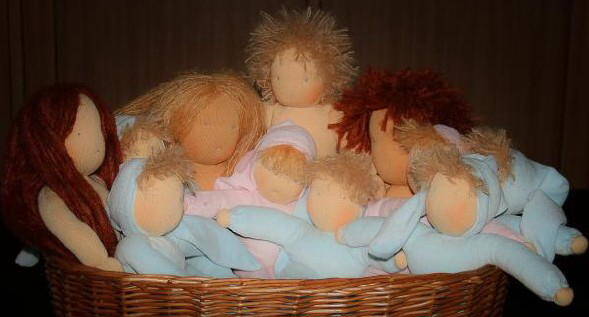
Waldorf doll tutorial – This Illustrated Handbook is the result of my experience as a mother and teacher.
I hope it will be useful not only to other mothers and teachers of kindergarten who want to make a gift to their children, but also for primary school teachers who want to teach their students to make dolls.
For many years I taught mothers and teachers of kindergarten how to build Waldorf and Montessori toys on their own, but the experience more interesting for me was to follow the workshops on the construction of the rag doll for children attending primary school …
… for this reason you will find instructions in the manual a little too detailed for an adult, and with stages that have not directly to do with the success of “handicraft”, but having an educational value when you working with children.
A special attention is also given to aspects of quality in relation to the small child who will play with the doll.
WALDORF DOLL TUTORIAL – download ebook
WALDORF DOLL TUTORIAL – TABLE OF CONTENTS
Necessary material
Start from the body or the head?
Head
Body of the doll
Body of the doll with articulated limbs
Hair
Long hair
Short hair
doll with fabric body and hood
Eyes and mouth
Instructions for making the patterns
Pattern for Waldorf doll – medium size
Pattern for doll with articulated limbs
Pattern for doll with fabric body and cap
Pattern for Waldorf doll – big size
WALDORF DOLL TUTORIAL – Necessary material
– White wool for stuffing; I recommend using good quality wool, especially if you work with children or if it’s your first doll. Using wool rich in lanolin, it will become much easier to work above the doll’s head, and it will get easier stuffing homogeneous and without lumps. But do not forget that this type of doll was not invented in Steiner schools: the rag doll has always been the toy of poor children, so you can make the padding with other materials poorer, although will require more effort. Unless the doll is made to a child allergic to wool, I do not recommend the synthetic padding: the doll in appearance looks the same, but to pick her up, loses one of its most important features: the weight. The doll will be too slight.
– Carded wool of your favorite color (optional)
– Jersey to make dolls. A cheaper alternative to the jersey may be to dye an old t shirt with coffee
– Cotton thread or lanyard very resistant for the ligatures (one for the kites is fine, for example)
– Thick cotton thread (the one for crochet work) to make the hidden seams
– Sewing thread, the same color as the jersey, for the final hand stitching
– Sewing needles for wool and for cotton thread
– A special needle for dolls: it is a long needle, but with the eye very thin (needles for mattress are not good because having a large eye can pierce the jersey, perhaps even while you work in the eyes of the doll …)
– Sewing machine, if you do not want to sew by hand the doll’s body
– articulated joints for dolls or bears (only if you want to make the second model)
– Cotton chenille (only if you want to achieve the third model)
– Wool yarn for hair
– Crochet thin enough to fit in the jersey, but able to take the wool that you have chosen for your hair
– Scissors
– Chinese chopstick or something like that, it helps a lot in the process of padding
– Embroidery thread for eyes and mouth
– Pink chalk to color the cheeks of the doll
WALDORF DOLL TUTORIAL – Start from the body or the head?
The answer depends on the type of experience you want to do when creating your doll.
If you are more interested in the success of the finished product, maybe it’s best to start from the body: this is because the body had already padded and shaped, it is easier to make a head of suitable proportions.
The doll, in fact, should have the following proportions: The body should correspond to the head length multiplied by three (from the neck to the navel is a head, so you can put a pin with, to mark the navel of the doll).
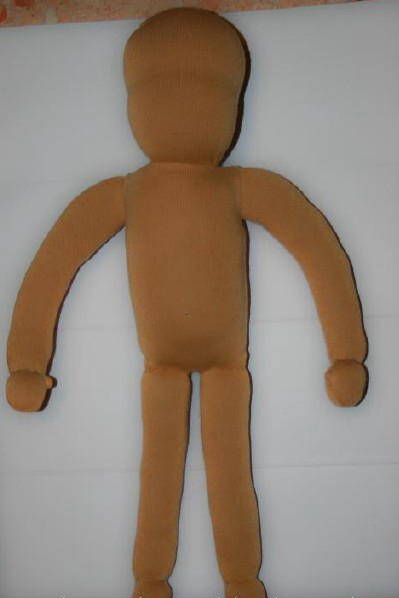
You can do a further test to check the proportions of the doll over, the foot must touch the nose of the doll.
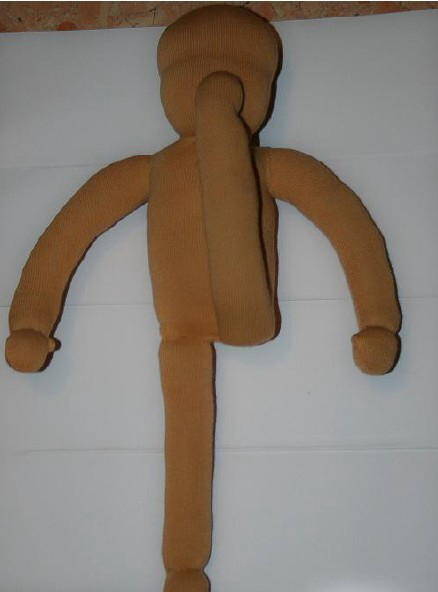
The arms of the doll should instead be able to touch each other, just below the tummy.
That said, however, start working from the head is much more beautiful and meaningful (the embryo develops from the head), especially if you want to make dolls with the kids, and the obstacle of getting a well-proportioned body is overcome easily , following the directions to make the patterns, you will find later in this handbook.
You are free to model a head the size you want, and depending on the result you can make your own pattern very easy, following the instructions given in the proper chapter.
This will make the job certainly more challenging. It will not be an experience of sewing, but an experience of perception of shapes and proportions, observation, and stimulate us to search for beauty in shaping this simple and modest image of the human being, which is the doll.
WALDORF DOLL TUTORIAL – The head
(For all models of doll)
(These are the instructions for the head of any type of doll; only measures, in particular, relate to the creation of the Waldorf doll medium size, but the process does not change for the other dolls)
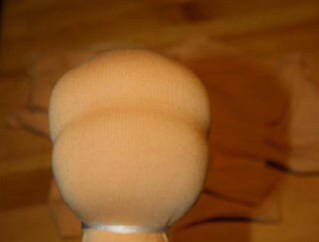
Before you start working on the doll’s head, remember that once finished, it must have the fundamental characteristics:
– Should be as hard as possible
– Must be round, smooth, symmetrical
– Must be very firm on the neck and should not dangle.
Remembering these characteristics, we can begin…
Choose a layer of carded wool of your favorite color: it will be the hidden light that will start all the work.
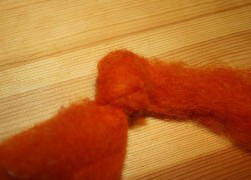
Formed a knot and then wrap around the wool excess as to make a ball:
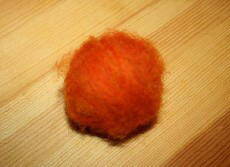
After you hide your secret, wrapping around the ball a little bit of other white wool, as hard as you can:
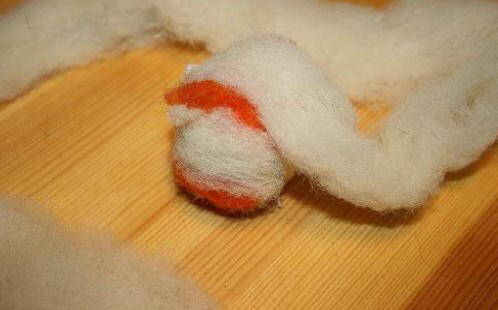
to obtain a ball with a diameter of about 7cm.
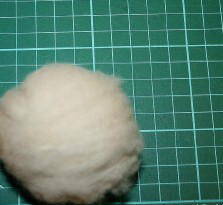
Then prepared with the other white wool a beautiful star on the table, and place the ball in the center of the star:
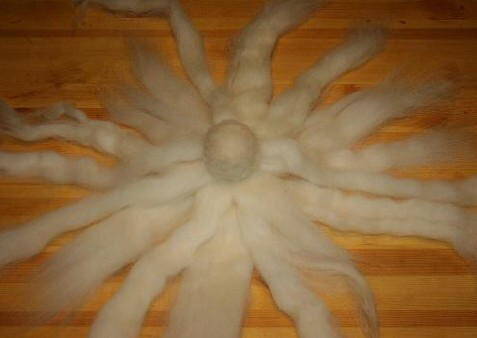

Beautiful, is not it? Now take the rays of the star, two by two, and use them to form precisely the head and the neck of our doll. Once you start the process never leave the grip until the final ligature.
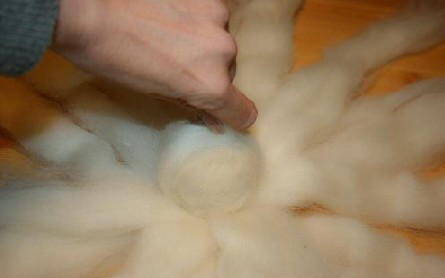
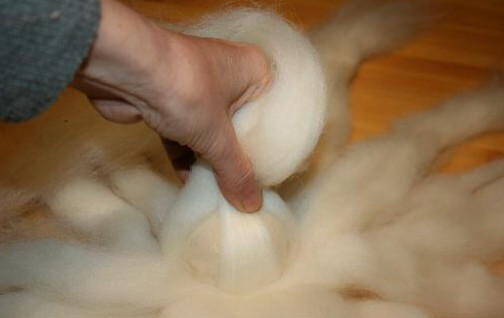
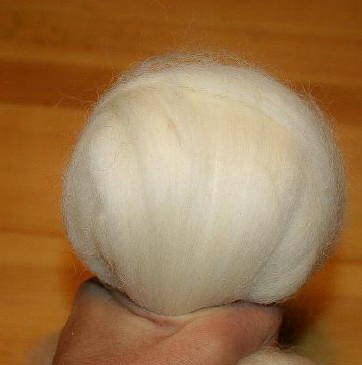
So, with very resistant lanyard tighten around the neck as hard as we can, and tie.
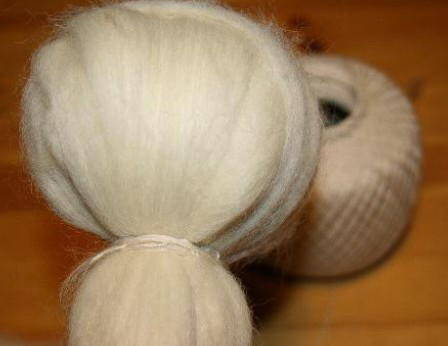
Now we can leave the grip, and with the other lanyard can reinforce the neck to a certain length, not exceeding the length of the head itself, and eventually cut the excess wool.
Our neck is very hard: we can just ask the children to touch their own necks, and also to follow up with your fingers as it continues down the back with the vertebral column: the column supports our head, in fact.
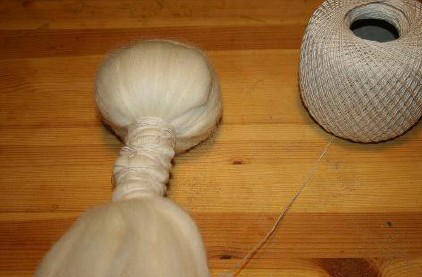
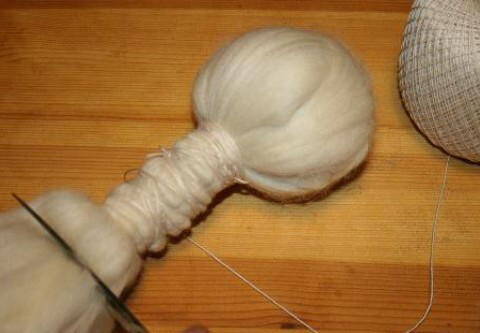
With regard to the size of the head at this stage, you have to keep in mind that at a later stage it will be reduced by at least 5 cm in diameter (even more if you have not wrapped tight enough) now measures 30 cm, after ligatures come to about 25cm.
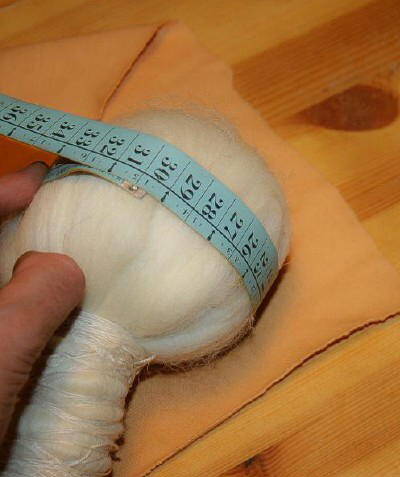
Now lay on the table the jersey.
Looking at it you will see that it has a right and a wrong side.
It’s very important that the ribs from falling onto the doll’s face vertical and straight. For the head, you do not need a pattern, but you have to be very careful in the preparation of the jersey before cutting it.
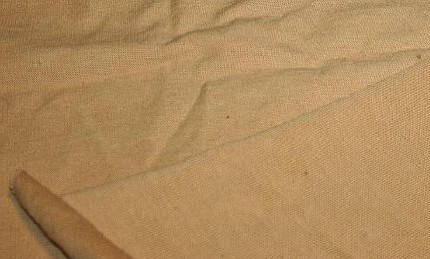
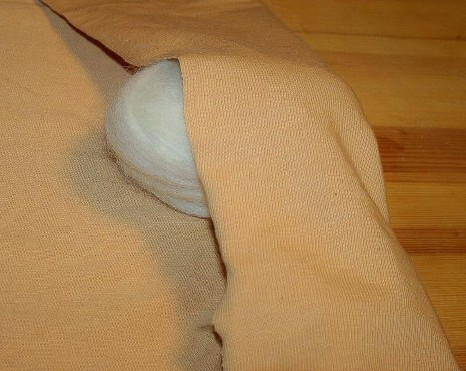
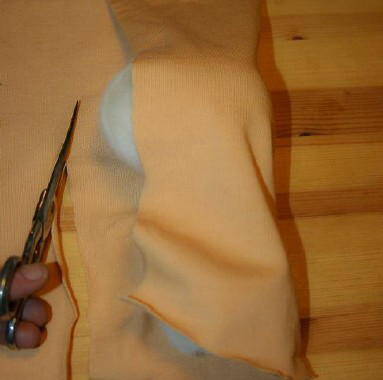
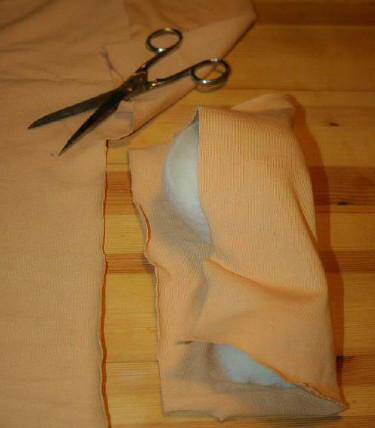
With some strong cotton thread, start sewing the jersey.
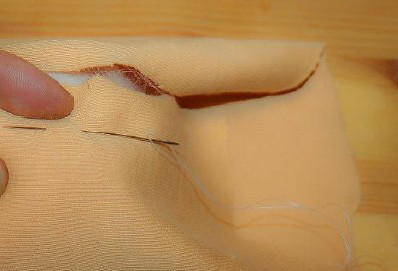
While you sew, pull the edges of jersey very well. The jersey must compress the wool. Start sewing from the nape and going down, then go back to finish near the forehead: we say that we leave open the fontanel. Sewing and pull well I use this stitch:
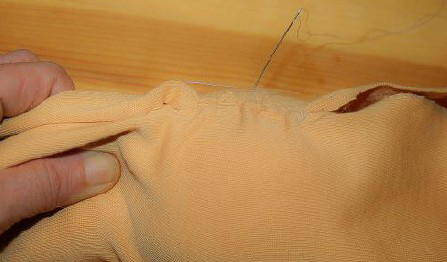

Nearing the neck, keep the jersey, and pull hard towards the neck, and also downwards: in this way will limit the formation of ugly wrinkles under the chin.
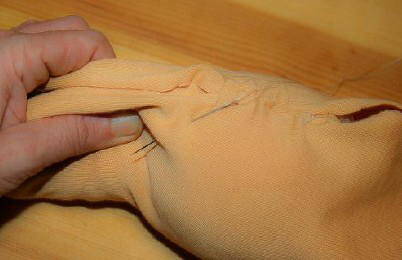
Then go back up, if needed, pull again the jersey.
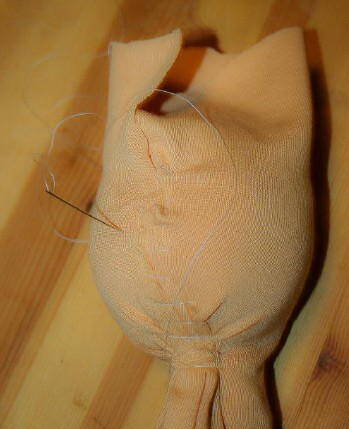
Proceed as shown in the pictures.
We have essentially preventing wrinkles appear on the forehead of the doll, then we must ensure that wrinkles, folds and stitching falling as high as possible, where they will be hidden by the hair.
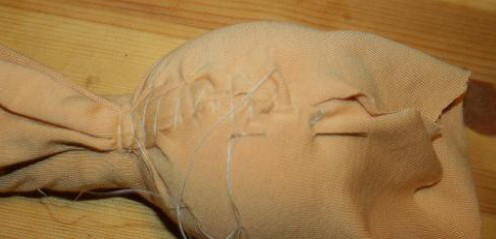
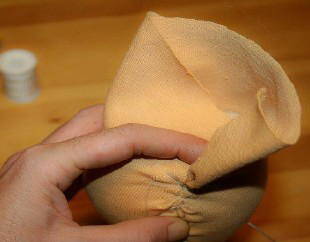
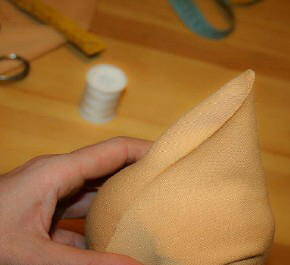
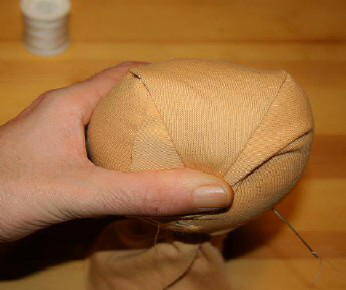
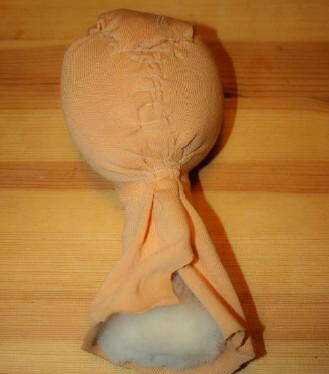
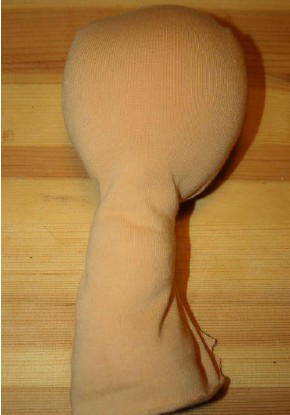
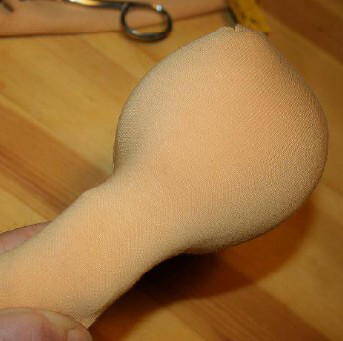
Now we pull the fine jersey downwards, before tying it tightly around the neck of the doll.
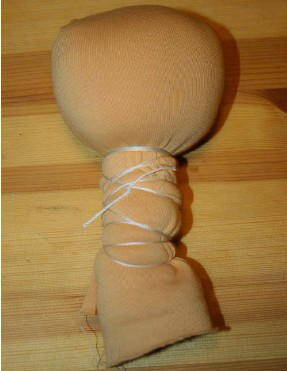
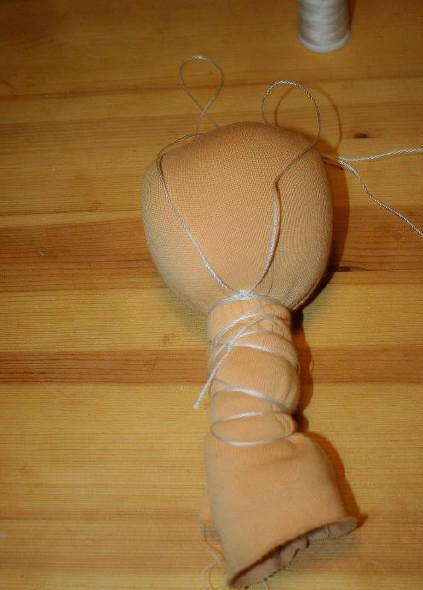
Cut the lanyard so that you have a whole lot available, and for the first make a knot just below the chin of the doll, leaving on both sides protrude two strings of equal length, abundant.
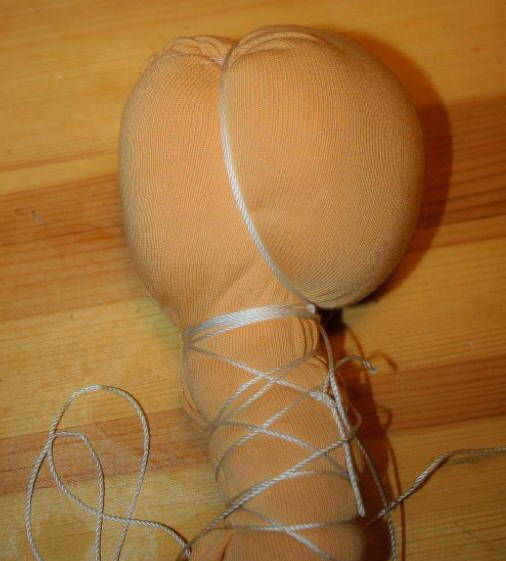
Now use the lanyard to make the ligature which serves to delimit the face of the doll, in this way:
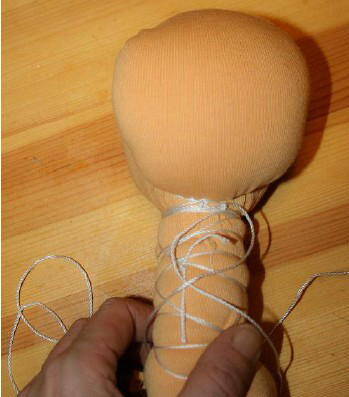
Tighten the lanyard very well, then the nodes very close, and use the remaining lanyard to further strengthen the neck.
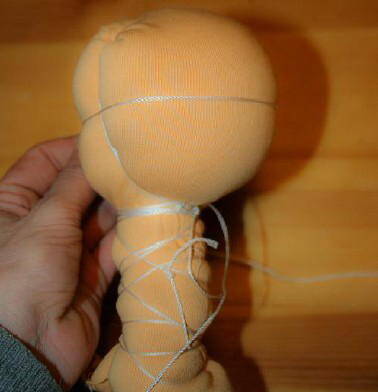
We now come to the most difficult step: the ligature for the eyes. First observe carefully the face of the doll, check that there are no wrinkles and that the jersey is tight and with the ribs perpendicular. Then cut a long piece of lanyard, and place it on the face of the doll, so that it is perfectly horizontal and falls approximately in the middle of the face. Do various tests, and then make the ligature, always checking that the lanyard falls on half of the face and that it does not become skewed.
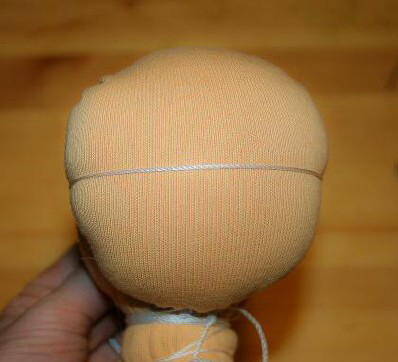
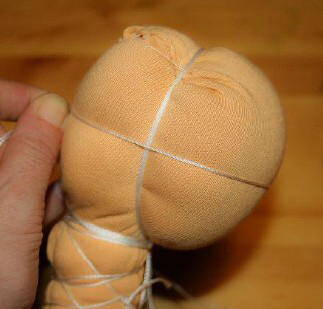
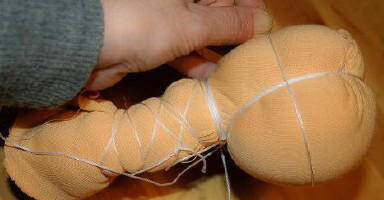
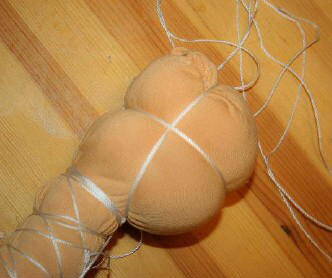
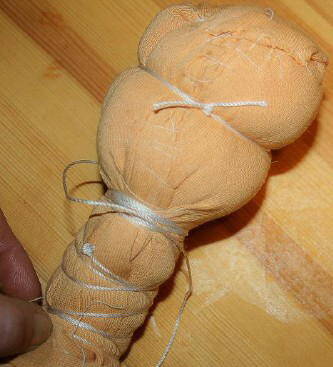
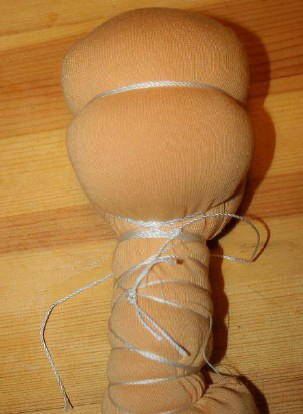
Now we need to firmly attach the lanyard to the head, at intersections, using the special needle for dolls, and other lanyard. Take with the needle, together with the jersey, a bit of padding too, in this way:
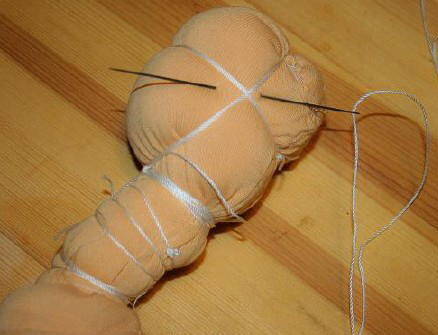
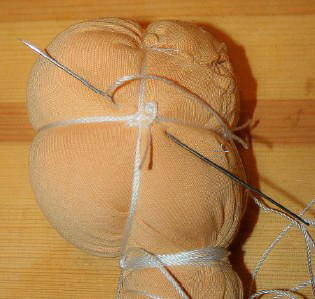
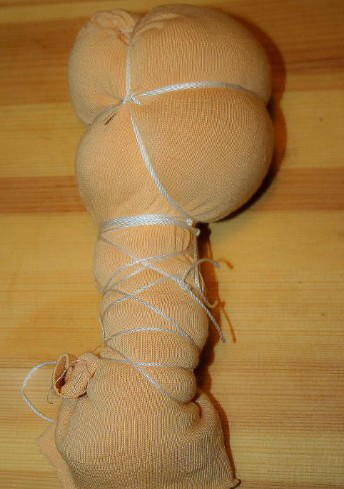
It’s very important to fix well these two intersections, because now we have to push down the lanyard which divides the neck, without altering the position of the lanyard on the side of the face of the doll.
To do it, may be useful to use scissors as a lever, trying to push also the padding, so as to form a beautiful nape rounded, and preventing the formation of bulges at the sides of the neck.
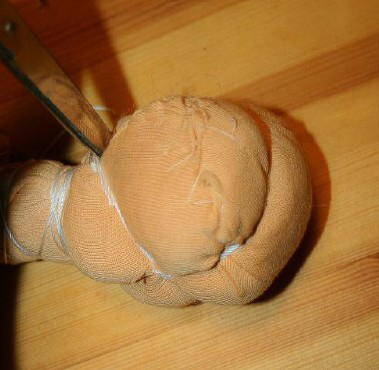
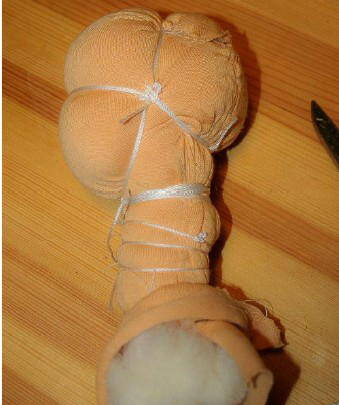
Now, to shape the nape and define more clearly doll’s face, with its soft, smooth cheeks and its nape harder and round, work with needle and lanyard as shown in the picture:
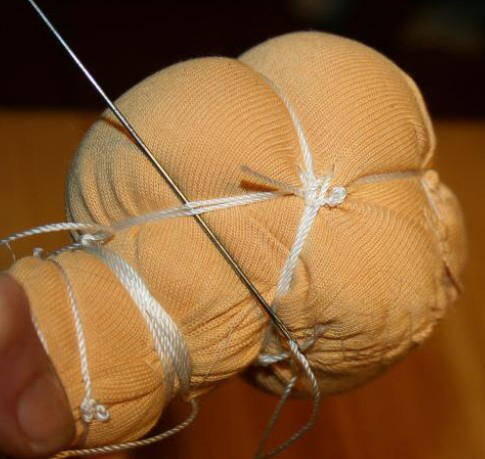
This work must not be mechanical, but it must be a work of sculpting; for this reason you can tell the kids to touch under their ears and then touching their nape.
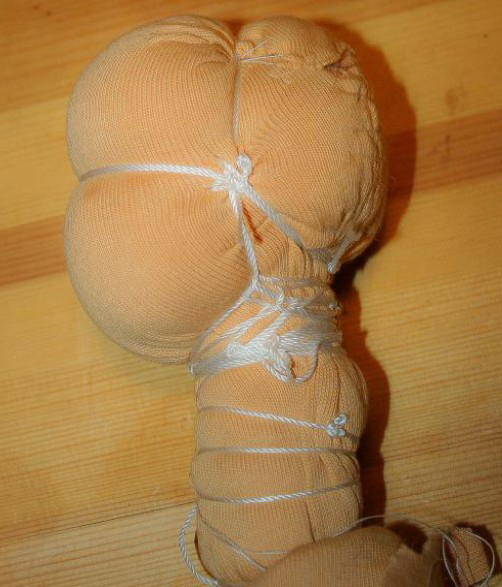
The head now is almost ready; we just have to cover it carefully with the other jersey, following the same procedure used before ligatures.
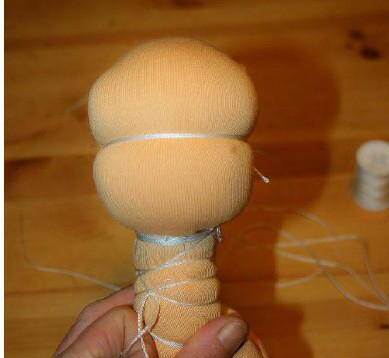
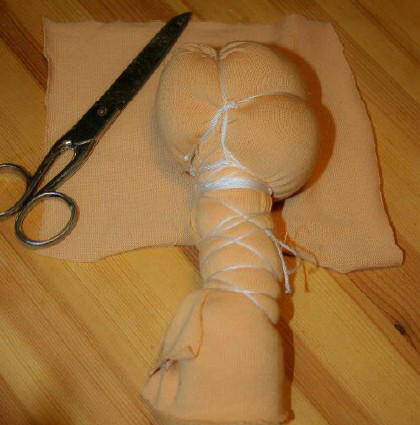
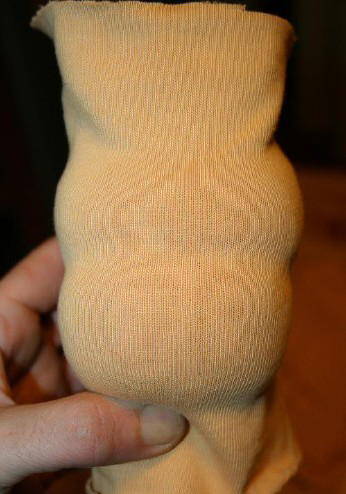
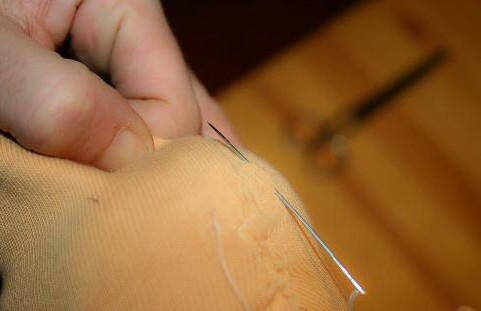
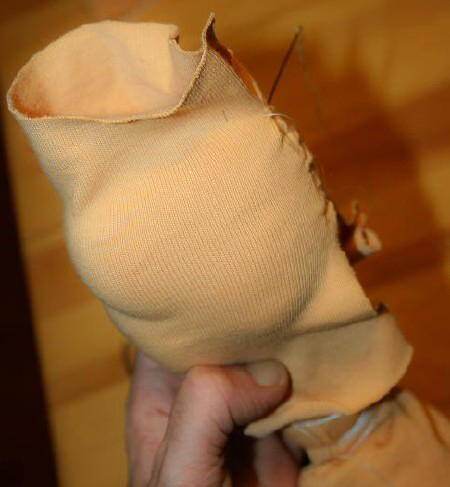
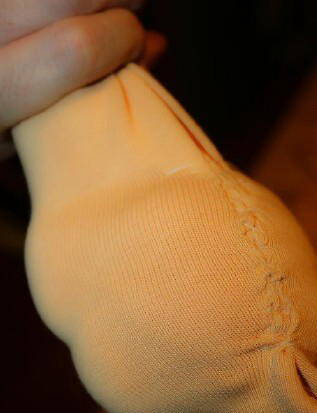
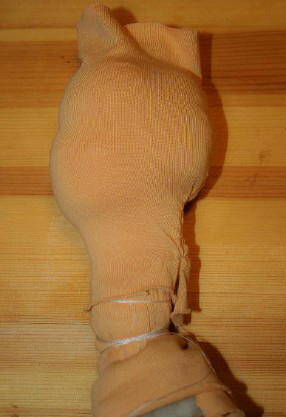
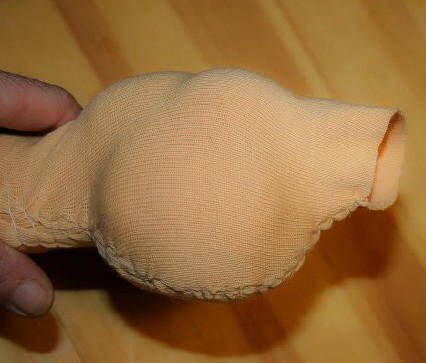
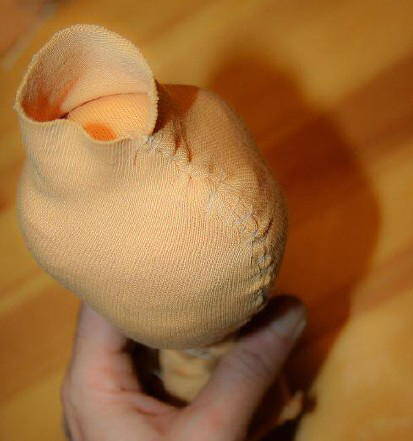
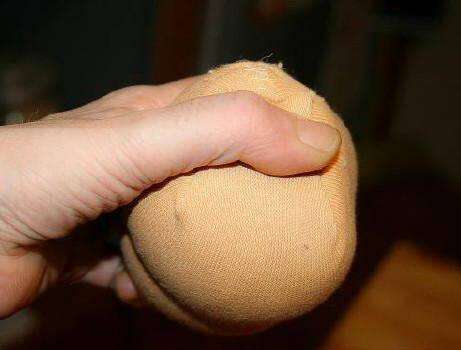
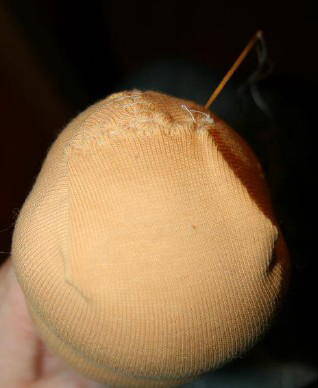
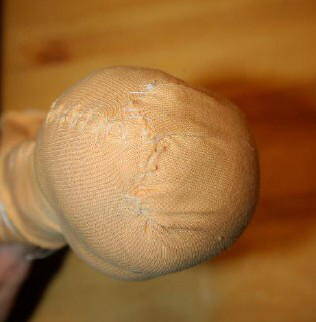
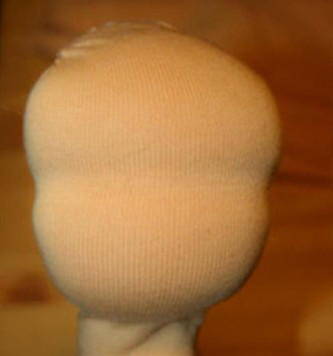
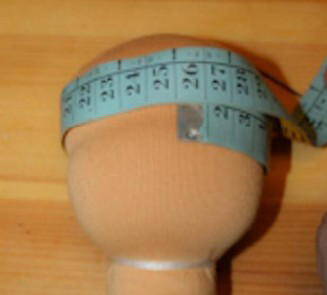
Finally fix the jersey around the neck with other lanyard. Now the head is ready, and measures approximately 25cm in diameter.
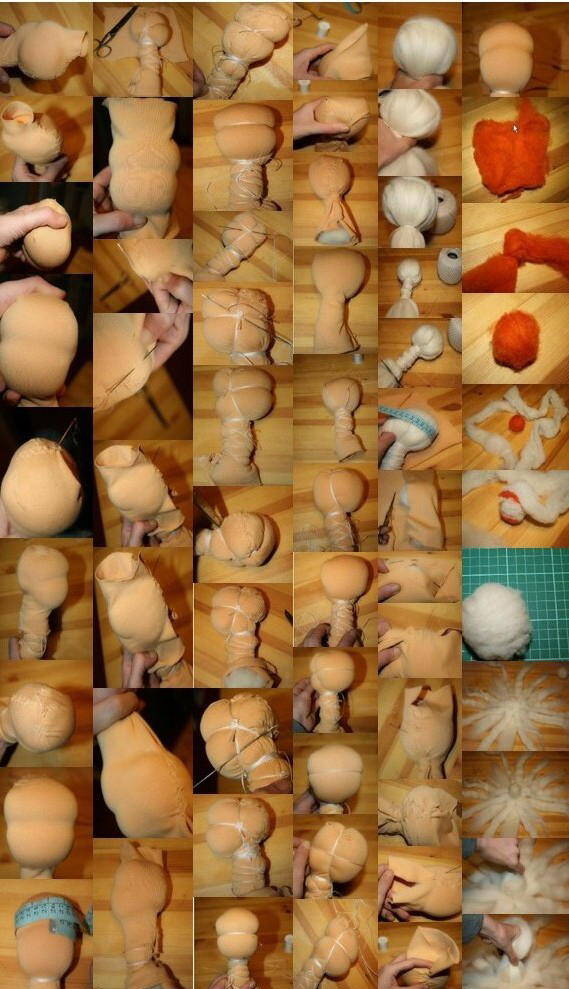
WALDORF DOLL TUTORIAL – Body of the Waldorf doll (head of 25 cm of diameter)
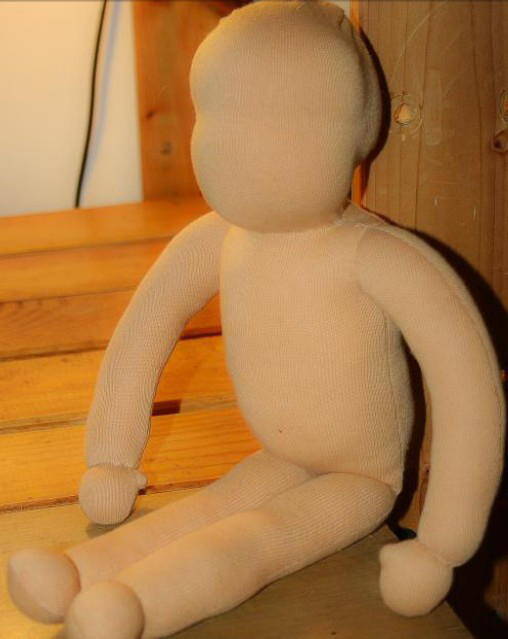
Prepare the jersey on the table, put it in double with the back to the outside and the ribs vertically, place the pattern,
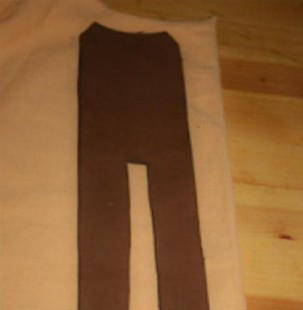
trace the outline and cut out.
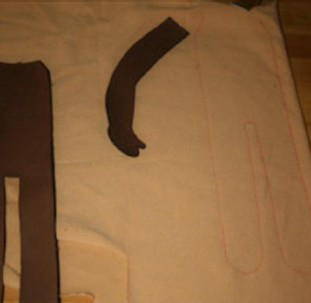
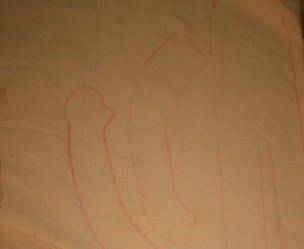
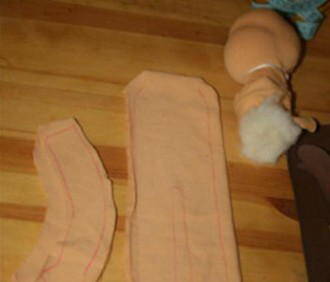
Sew along the lines of the body and arms, with the sewing machine or by hand. If the jersey is of good quality is not necessary the zigzag stitch on the edges.
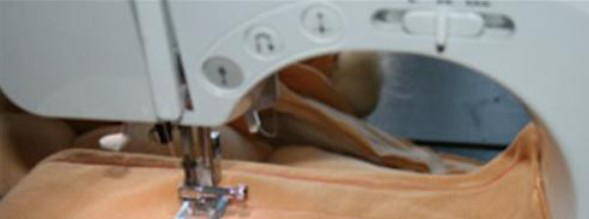
So with scissors follow the contours leaving a margin not exceeding 1 cm, and make small cuts additional at the crotch and at the thumb of the hand.
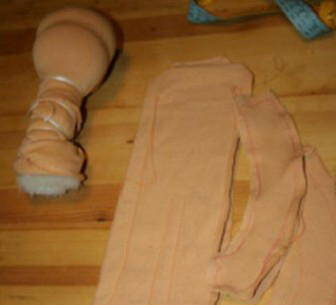
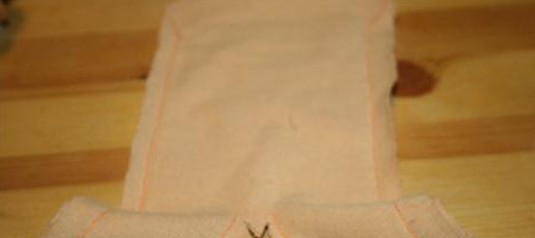
Turnover and do the padding.
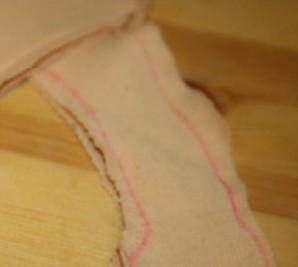
To make the doll’s padding we need to keep in mind that we want the doll has a consistence toned and not flabby, and that it has a smooth appearance and without lumps.
The easiest way to achieve this is to insert a small flap of wool at a time and always push the center with the aid of a Chinese chopstick, so even if in the centers of the pitch of wool remain the signs of pressure, outside the padding will be pretty smooth.
Let’s start with the padding the feet and legs of the doll.
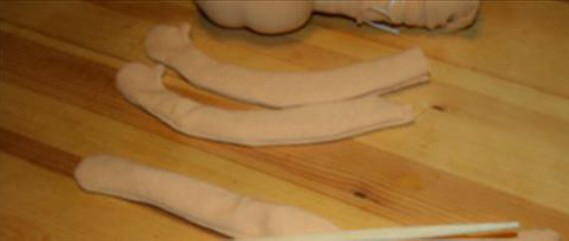
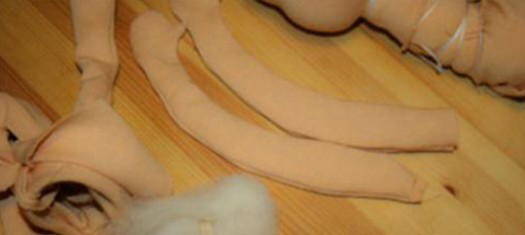
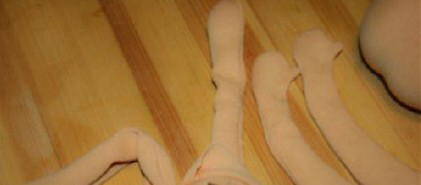
Arrived at the crotch of the first leg with the padding we stop, we aim a pin for holding it all, and move on to the second leg. If we want the doll, once completed, can be well seated,
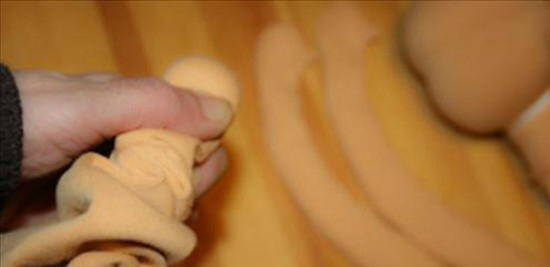
Is very important that not too go up with the padding. Then, with the strong thread of cotton, we make two seams symmetrical, which subsequently will be hidden, in the finishing phase.
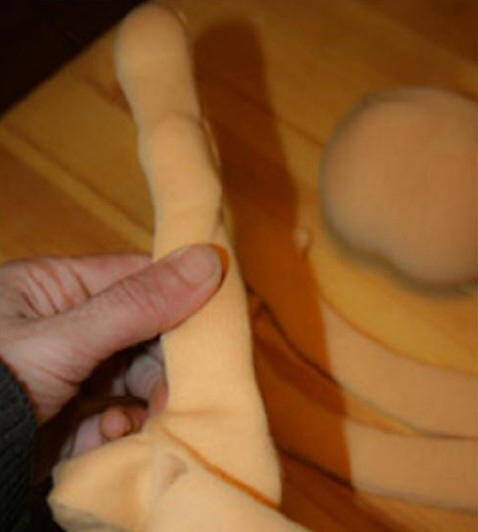
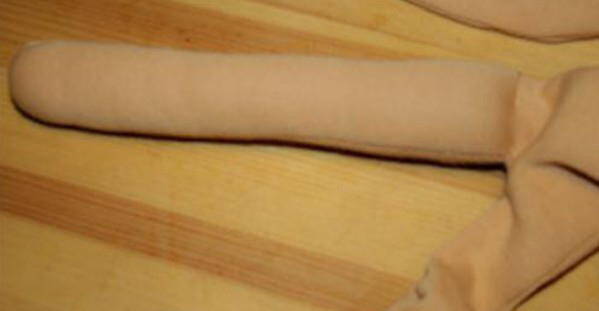
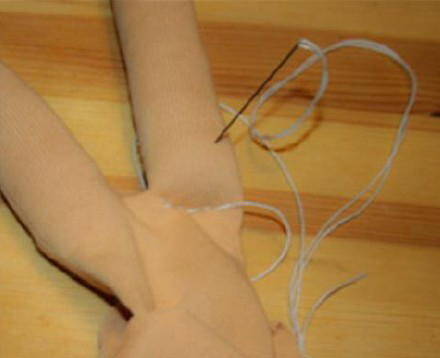
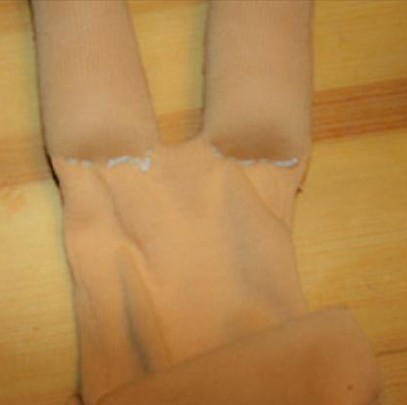
Following the same principles, let us padding hands and arms of the doll:
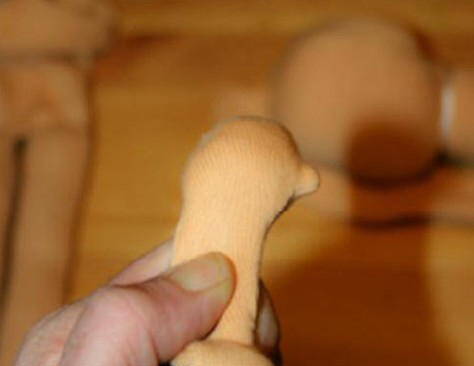
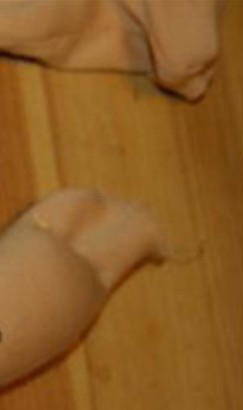
Then let us join hands to “ribcage” making the shoulder. Before sewing, you must carefully observe the doll, do various tests and once it reaches a good symmetry, secure with pins and then sews.
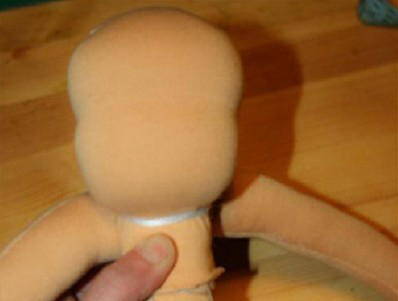
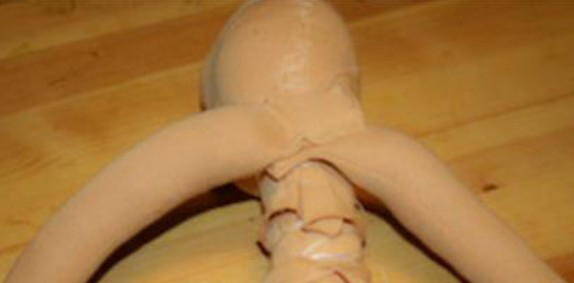
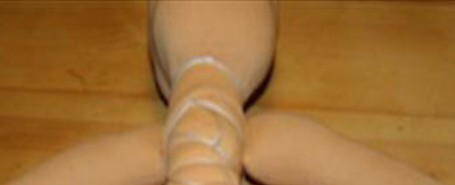
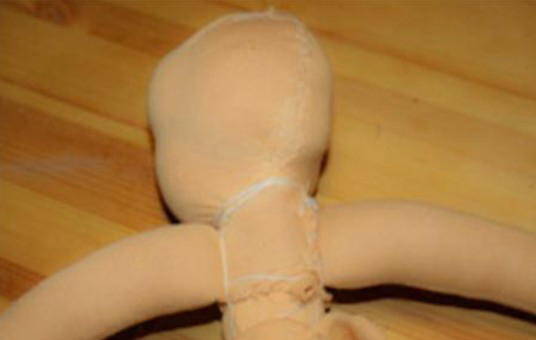
We can now join the two parts of the doll, by inserting the “spinal column” in the belly and continuing to padding, but this time without compressing too much, and trying to give the tummy a good look rounded and more flat in the back. Every now and then do tests to check that the doll can be well seated.
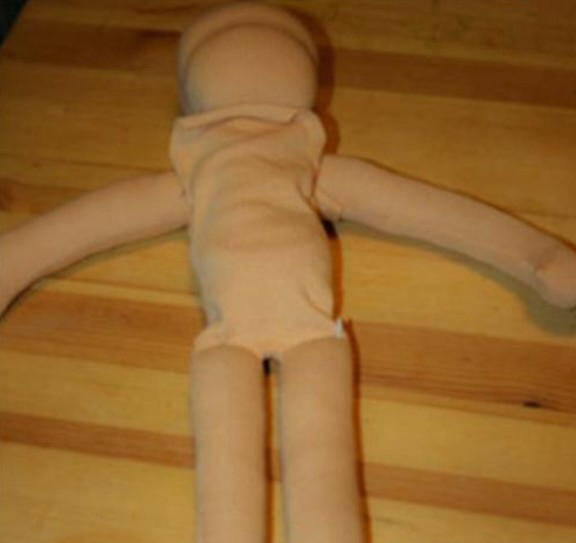
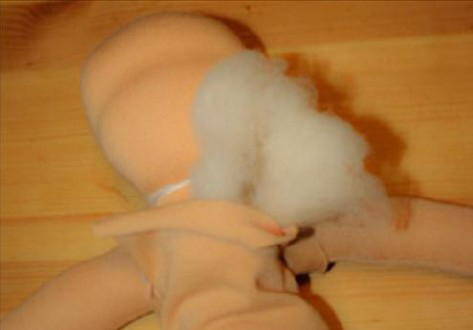
If the doll is stiffened, it means that you are too much padding at the seam between the legs and belly.
Came with padding up to the armpits, stand. We have reached another delicate point of the process: the shoulders.
First, to check the symmetry of the arms, interlink the hands on the front of the doll, keep the doll sitting, and observe it as a whole, and particularly the shoulders.
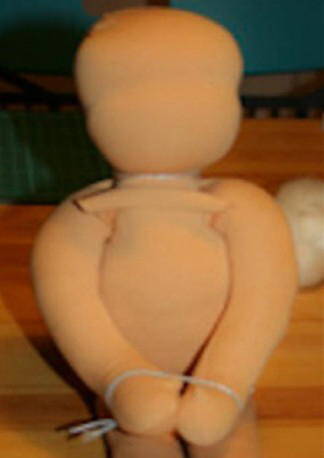
If all goes well, we can breathe a bit the jersey of the belly, toward the chin of the doll. Untie the hands, and start sewing with a thread of the same color jersey, with tiny invisible stitches, up to a few centimeters around the chin, and then for a few centimeters behind the center of the nape.
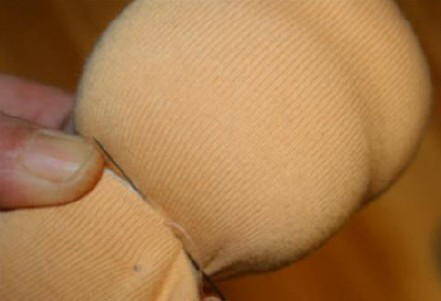
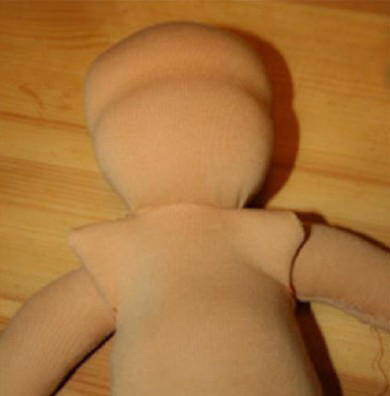
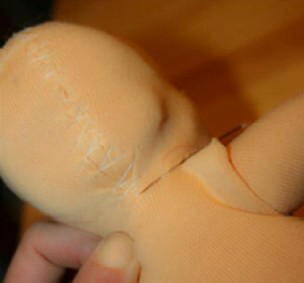
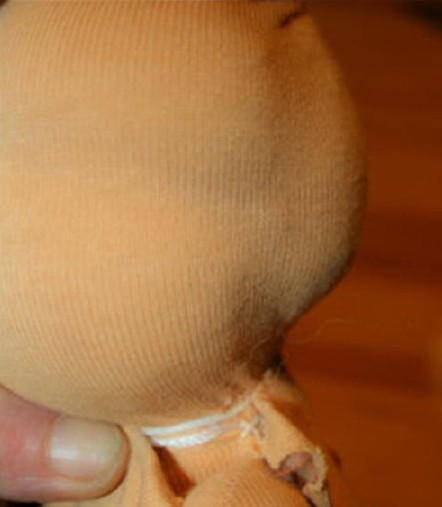
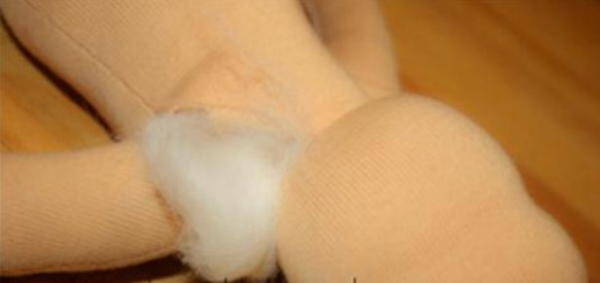
No obstructions should the shoulders of the doll.
Touch our shoulders: they are hard and round. Proceed with the padding of the shoulders of the doll from the front and from the back.
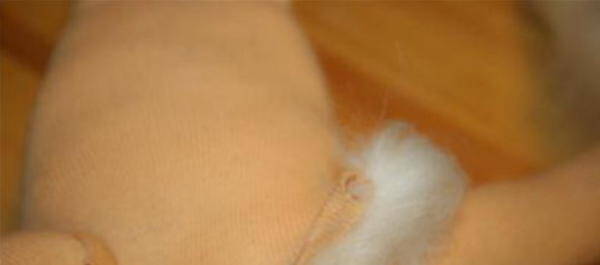
Padding behind, be careful not to overdo it, or we may make a doll with a hump…
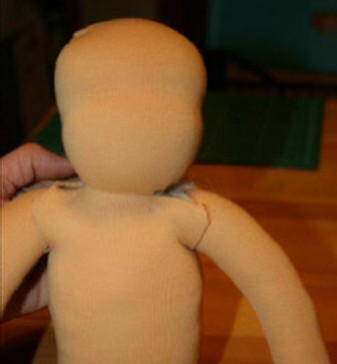
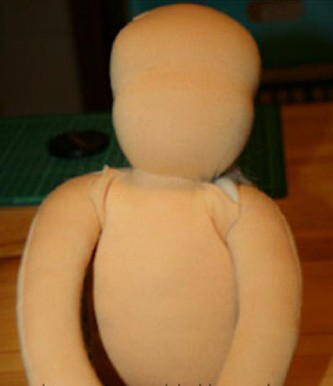
Tie the hands again on the front of the doll.
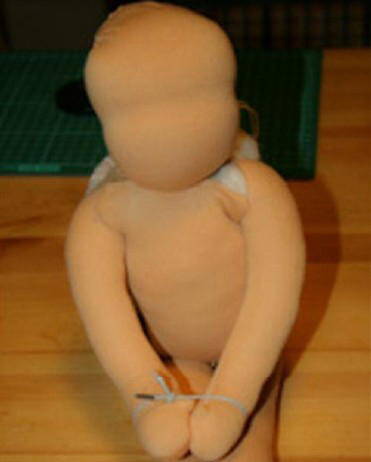
If needed, add the last layers of wool to pad. Usually at this point there is always to add a bit ‘of wool under the armpits, but not always. At this point we can complete the seam of jersey around the neck of the doll, pulling it much, and doing so a remainder a couple of centimeters for covering the shoulder.
If needed, add more padding, then bring the jersey towards the arm, fasten with pins, perhaps by making fits around the seam line of the arm, and sew
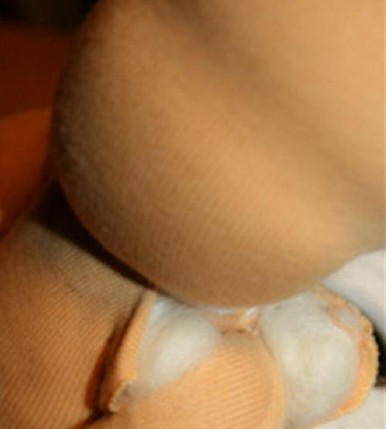
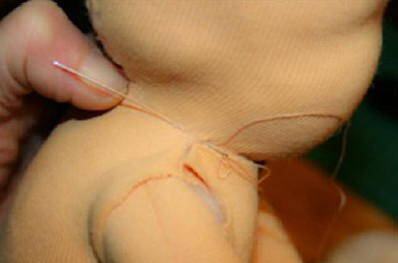
Fold the edges just barely, and also sew around the arm
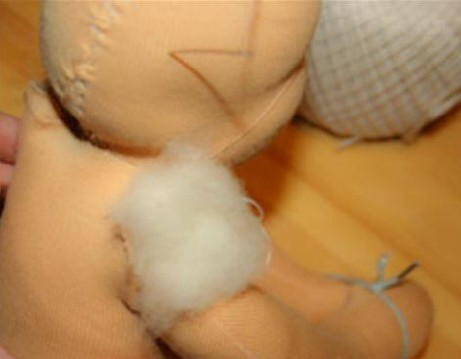
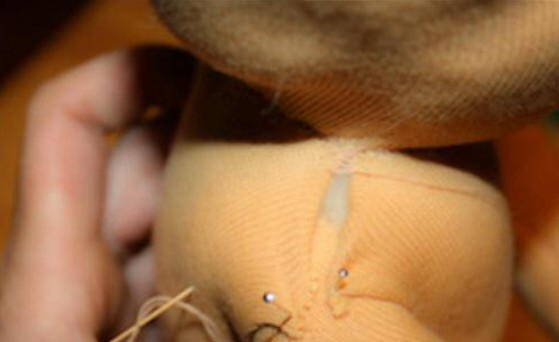
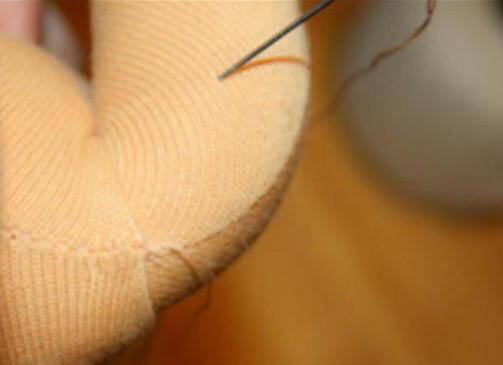
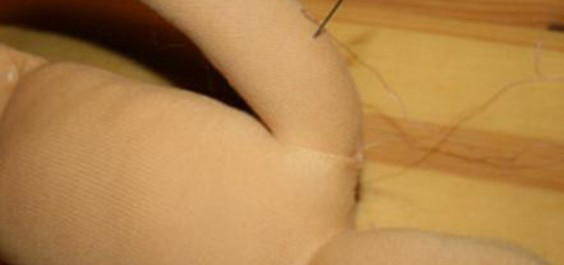
Finish the seams of the two shoulders; shape the hands of the doll. First, wrap a little lanyard to create the doll’s wrists, tighten and tie well.
We check that, after ligation, the hands appear of the same size, and then sew with small stitches and using the thread of the same color of the jersey, to hide the ligation,
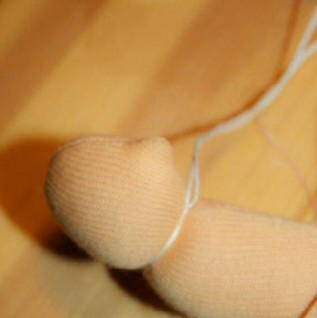
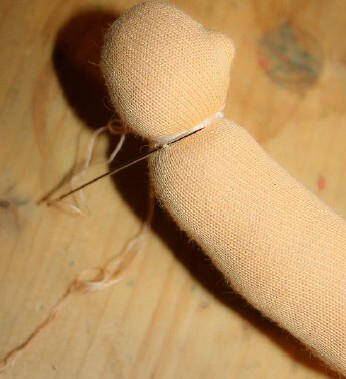
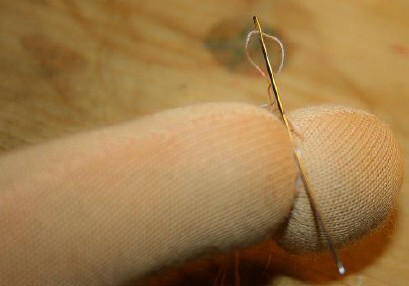
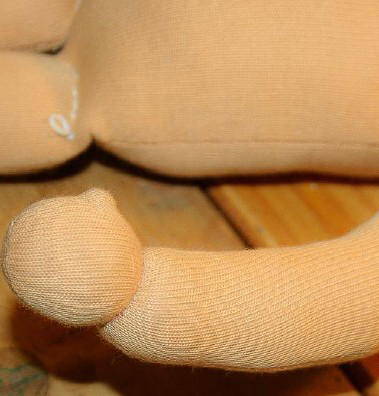
For the feet tighten only the front half, entering the needle in this way and pulling strong.
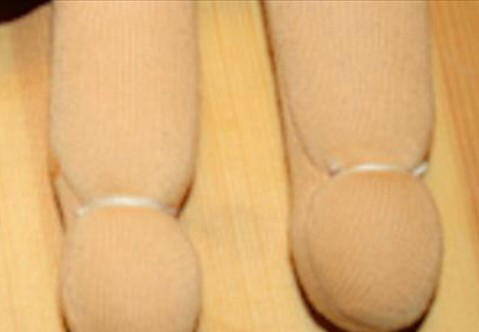
Then shape the foot pressing and doing so that it protrudes forward, in this way:
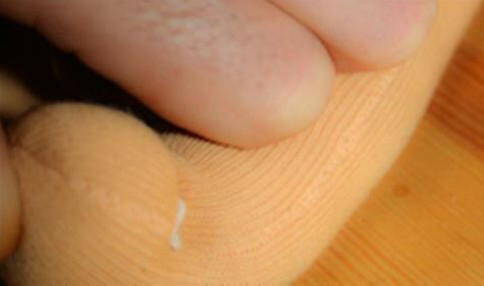
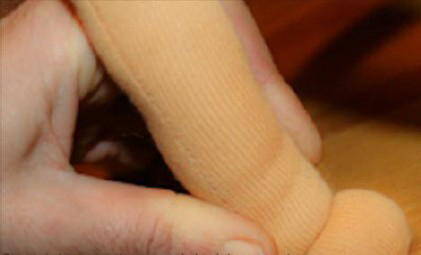
Then sew, as done for the hands of the doll.
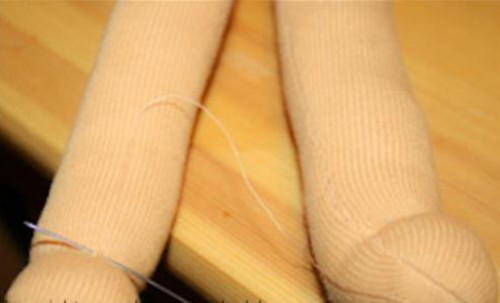
Finally hide the seams made for the articulation of the legs, with tiny invisible stitches, as done for the hands and feet.
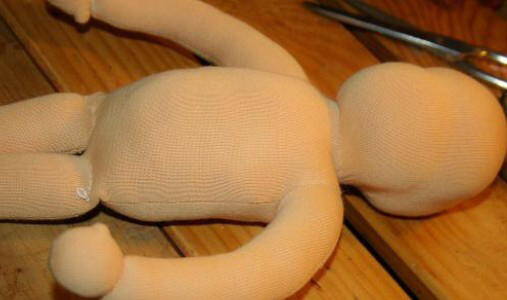
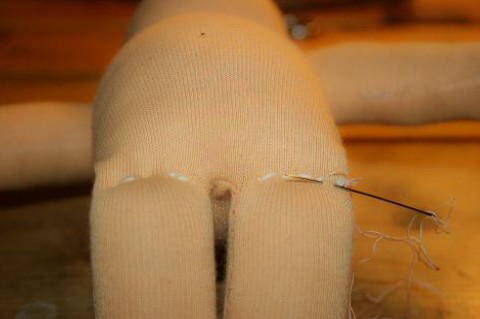
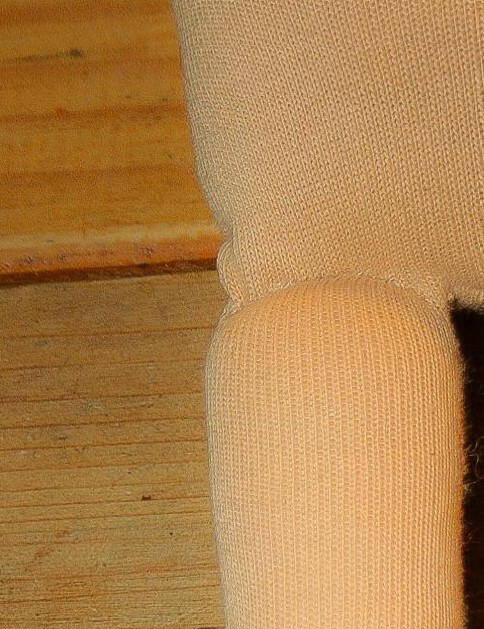
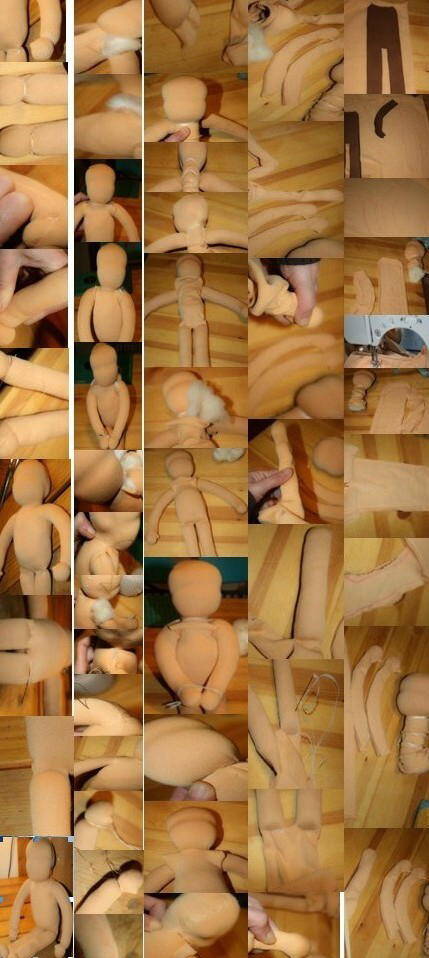
Now remains to be done only the hair, eyes and mouth…
WALDORF DOLL TUTORIAL – Body of the doll with articulated limbs
(Pattern for the head of 25 cm in diameter)
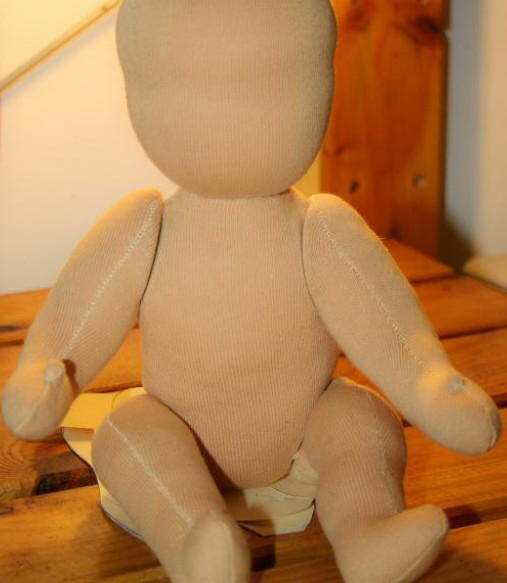
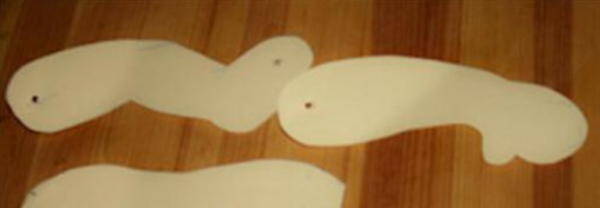
Lay the pattern on the jersey made double, draw and cut out once the body and arms and legs twice. Sew following the instructions on the pattern.
Prepare four joints for dolls or bears
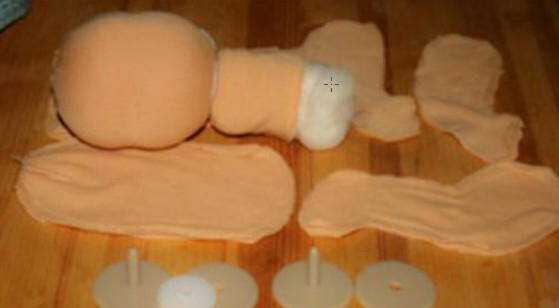
Turn the body of the doll on the right, through the opening of the neck
To turn the limbs instead is necessary to make a hole with scissors, as shown in the pictures. The hole will serve then to insert padding and joint.
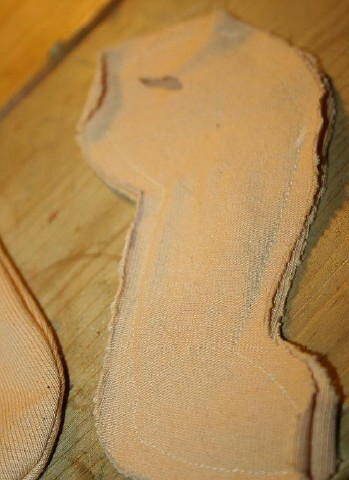
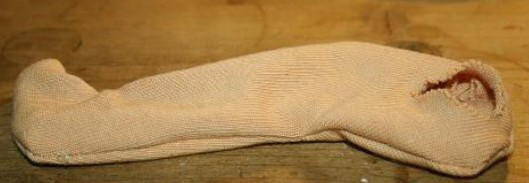
Make the padding as explained for Waldorf doll, using a Chinese chopstick.
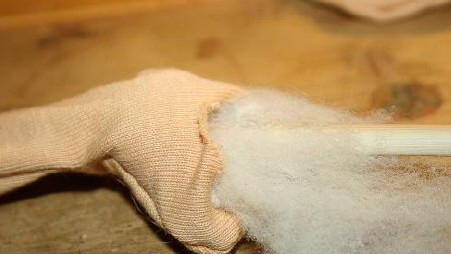
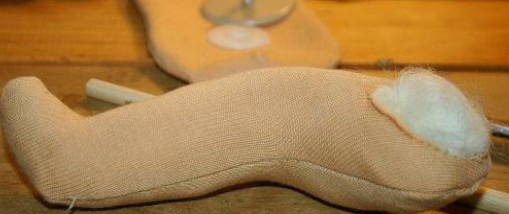
Insert into the hole the joint, as shown in the photo, and sew all around.
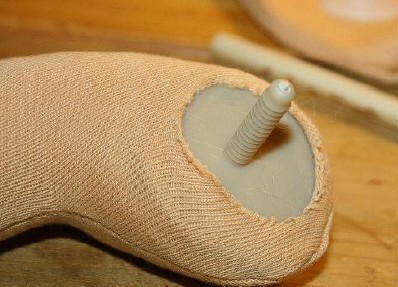
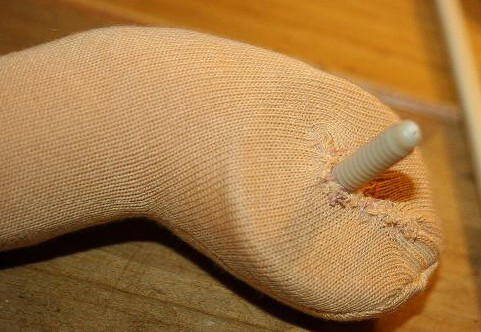
Do with a crochet hook a hole in correspondence of the signs present on the pattern, on the front of the body
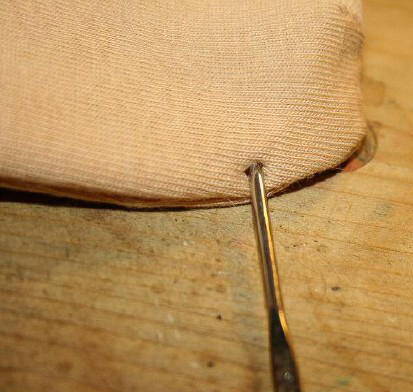
Insert into the hole the projecting part of the articulated joint of the leg, and insert from the inside insert the large disk and then the white small plastic disc for the locking.
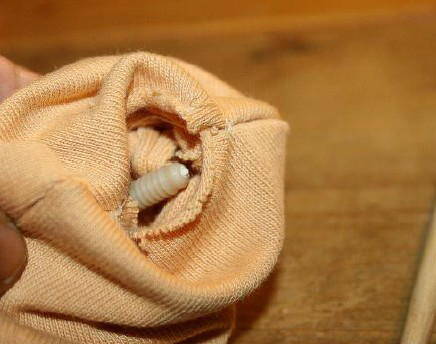
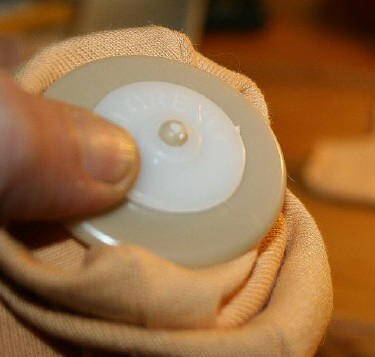
Follow the same procedure for all the limbs.
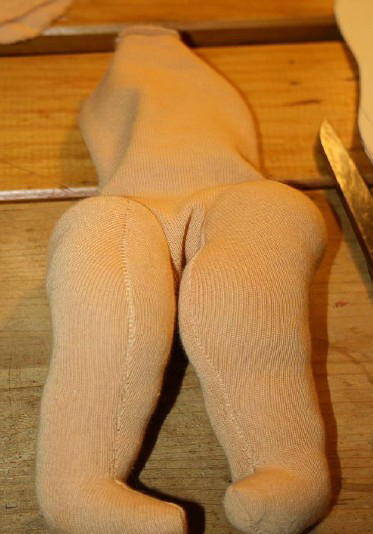
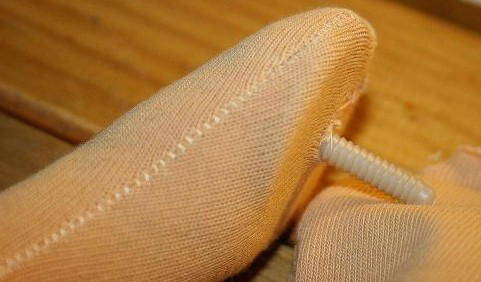
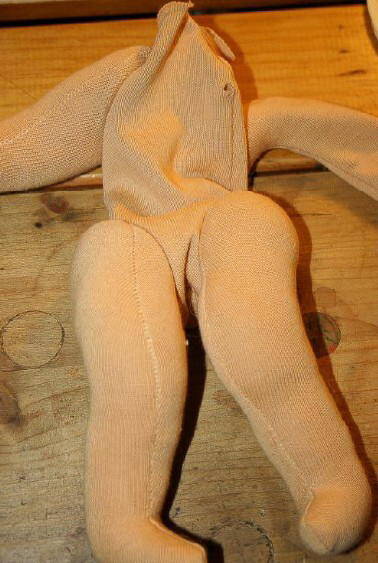
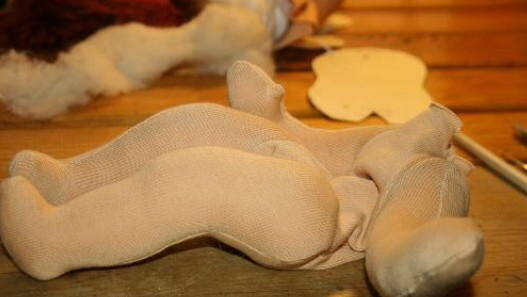
Padding a bit and then insert the head
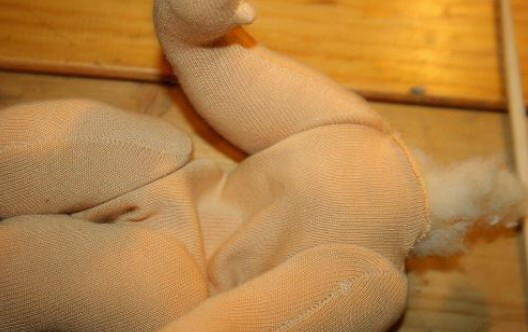
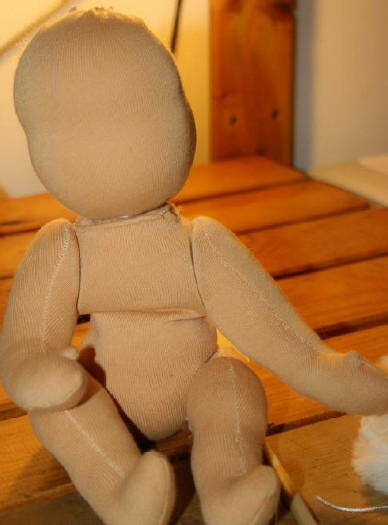
Continue with the padding:
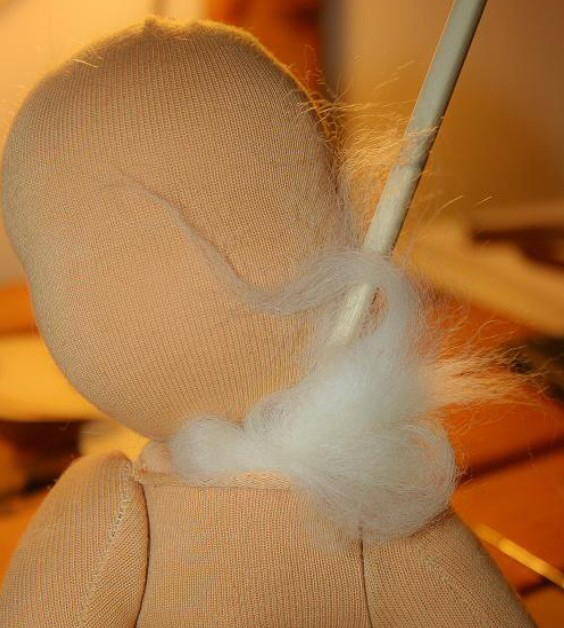
Then sew the jersey of the body around the neck of the doll, with small invisible stitches.
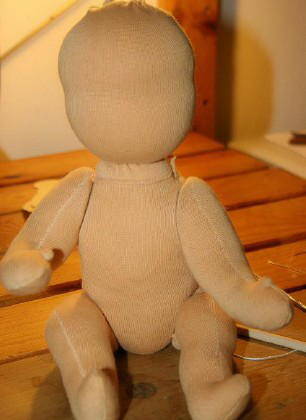
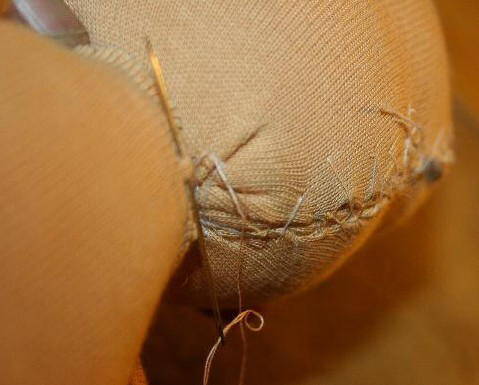

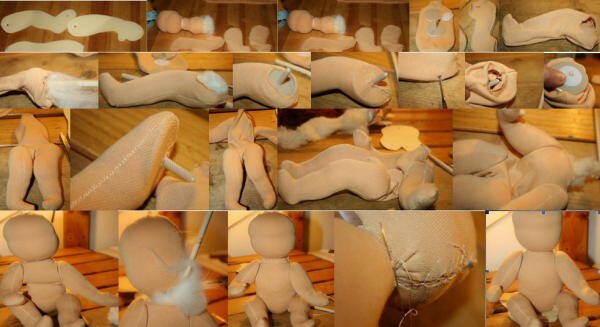
Remains to be done only the hair, eyes and mouth…
WALDORF DOLL TUTORIAL – The hair
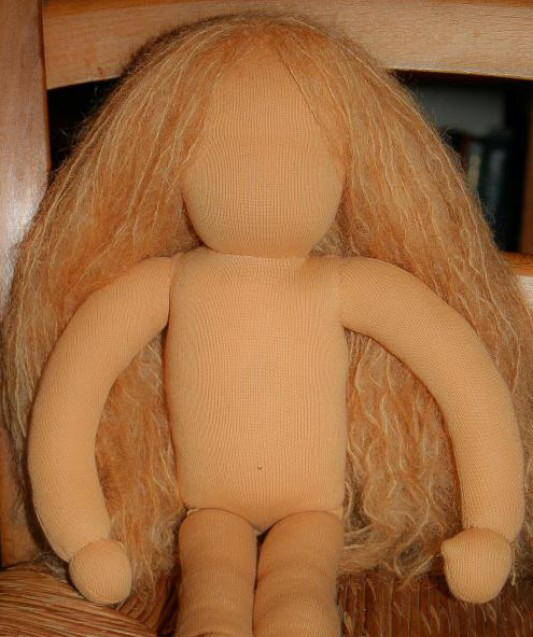
First you need to draw on the doll’s head these marks:
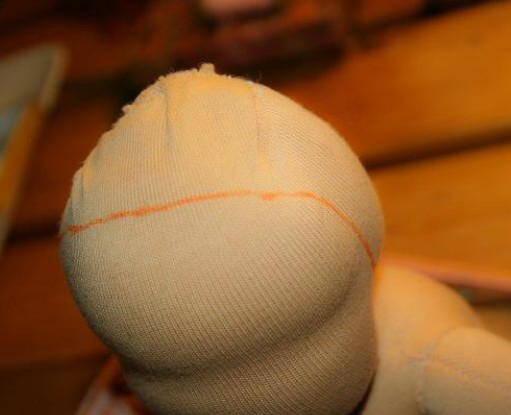
Pay attention to the hairline: follow the track of the ligature until the intersection with the ligature of the eyes, then draw near to the face a little ‘more, with a mark symmetric, but remain rather back because otherwise the hair will tend to cover part of the face.
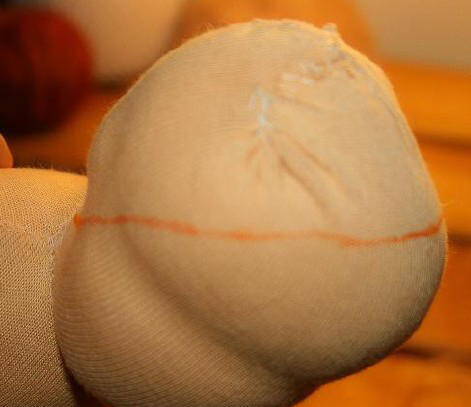
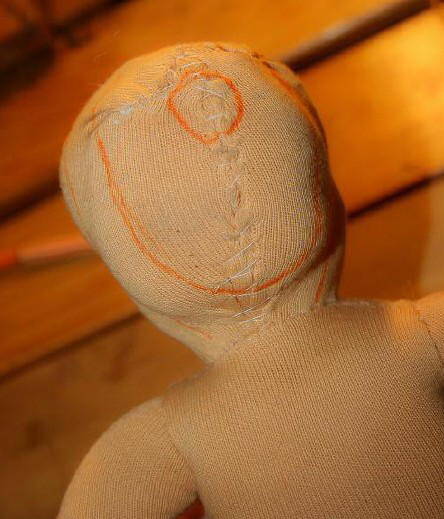
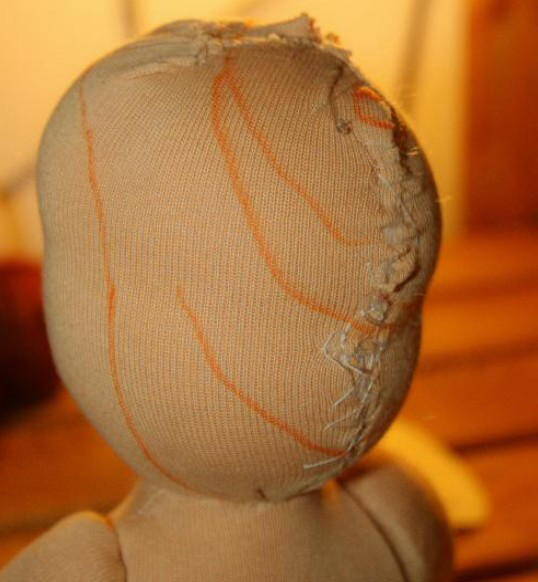
Now, following the marked lines, embroider the skin with wool choice for hair:
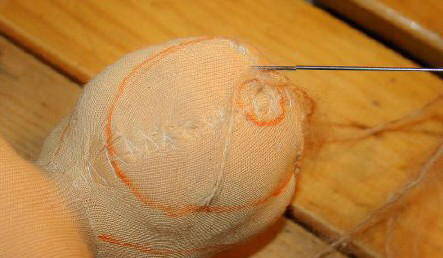
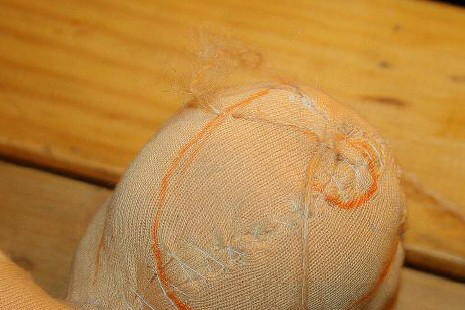
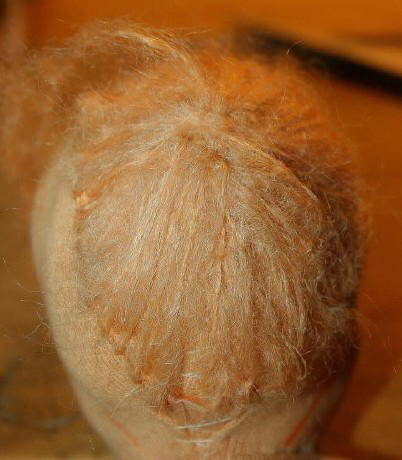
When we arrive at the hairline, hide the marks made by pointing the needle slightly forward.
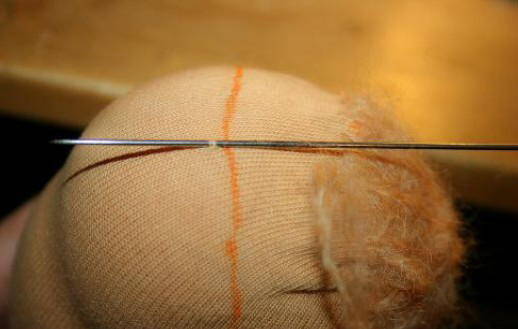
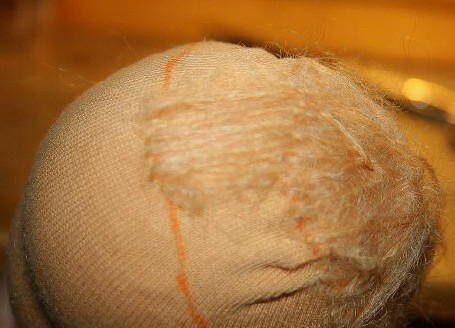
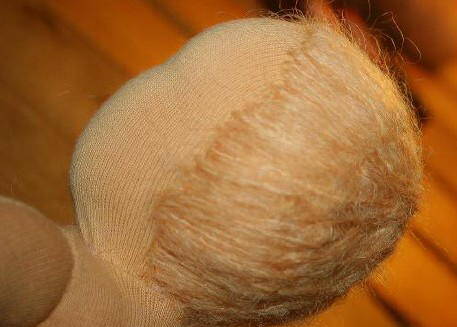
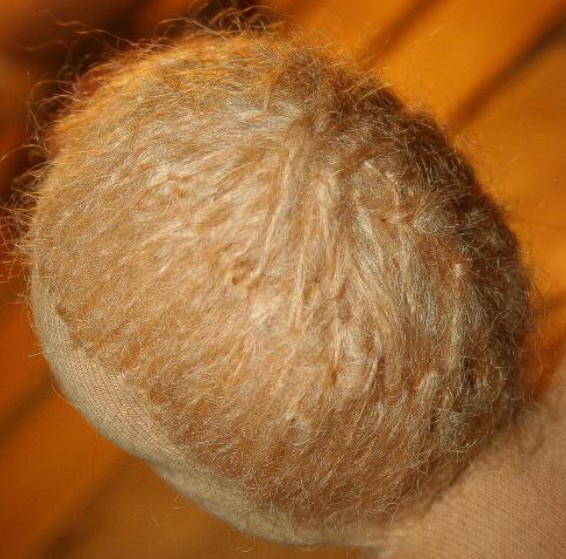
WALDORF DOLL TUTORIAL – Long Hair
Prepare a skein, then cut two times (the length of the threads obtained is the double of effective length of the hair, that is with a thread are obtained two hairs):
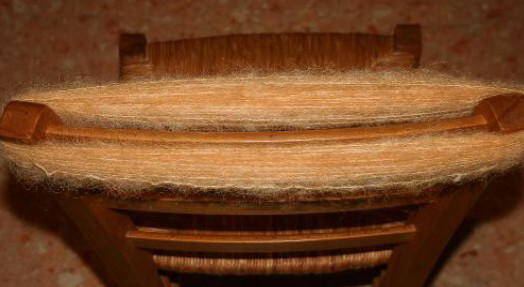
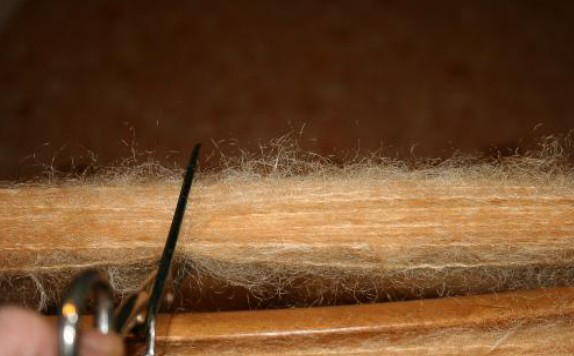
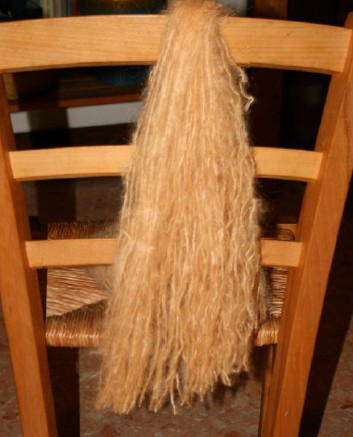
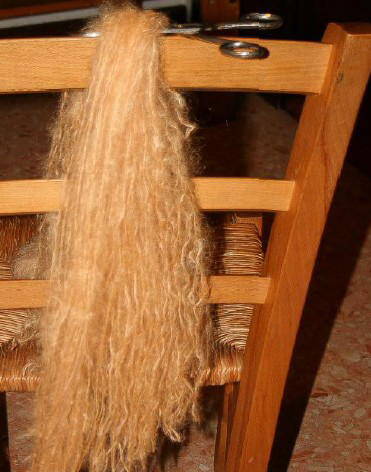
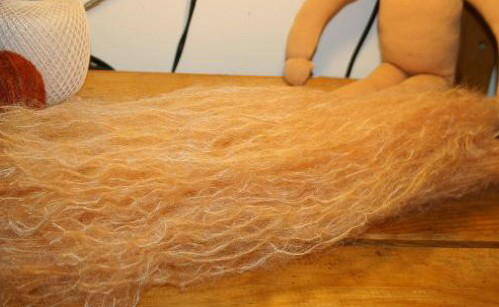
With a crochet hook (as mentioned above, the hook must be large enough to take the wool yarn, but small enough to fit in jersey without damage), point under the embroidery, taking a little ‘jersey. You can also choose to use a crochet hook bigger and take only the embroidery,
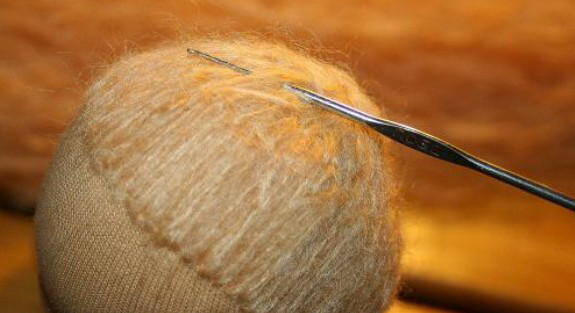
it is less tiring, but considers that children really like combing the hair of the dolls, and during the game the difference is noticeable…
Then take a thread of wool between those prepared, fold it in half and take it in their own half. Pull with crochet hook to form a loop.
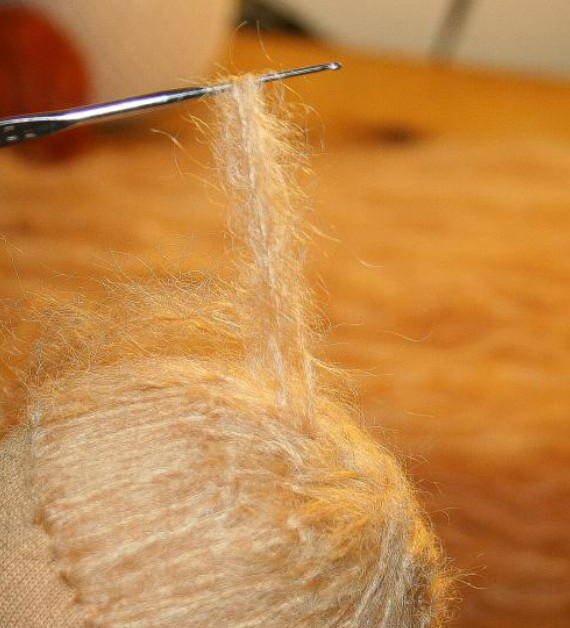
Take, with the hook, the two wool threads that protrude upstream, let them pass completely through the loop and pull…
Two hairs are made!
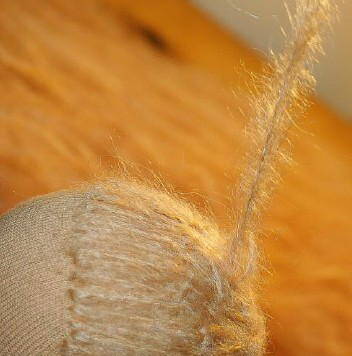
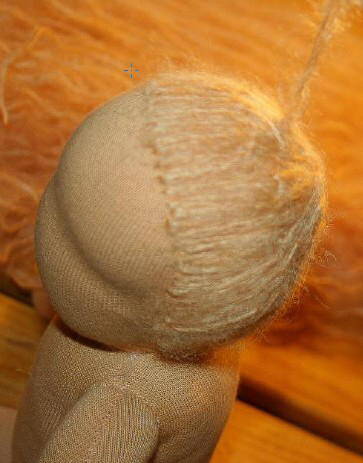
Continue in this way for the whole head. I suggest starting from the hairline, where it’s nice that there are a lot of hairs, and then we can gradually thin out, because if you put too much hair, it will be difficult for children to play with them.
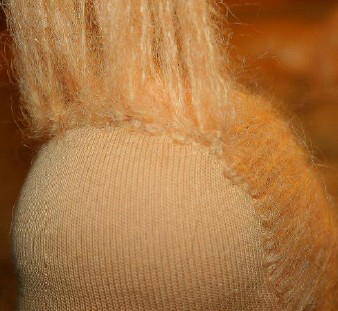
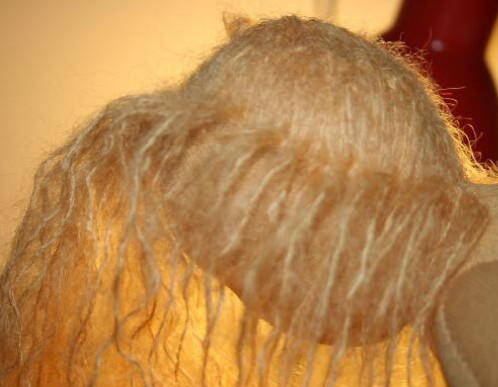
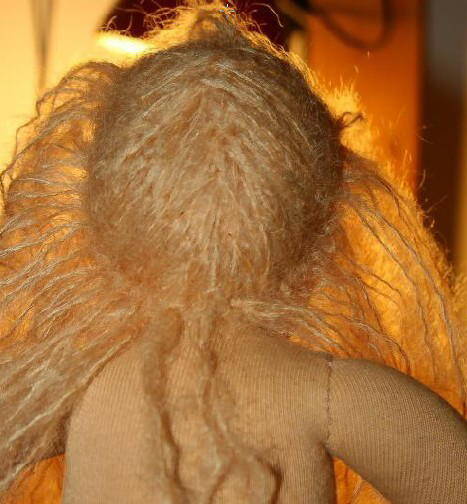
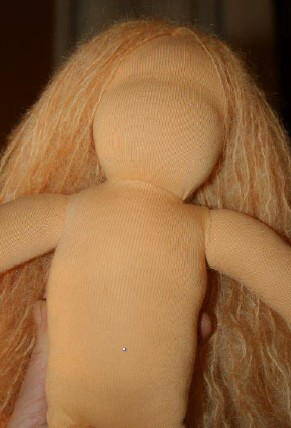

That’s it. Children usually love the fringe but the problem is that the fringe of the dolls tends to rise as a crest. I recommend giving children the doll without it, and then they can do the hairdresser, if they wish…
WALDORF DOLL TUTORIAL – Short Hair
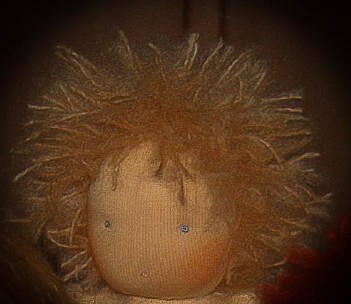
Prepare the hair for double length, but instead of wrapping around the back of the chair, use index middle and ring fingers and cut only once. You will get many tufts like this:
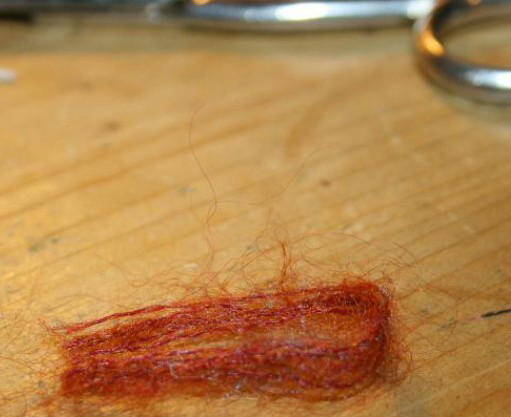
The doll’s head must be embroidered as shown before.
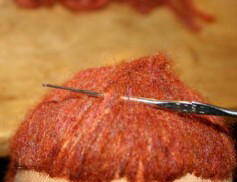
Insert hook, taking along with embroidery also a little jersey, then take the first hair like this:
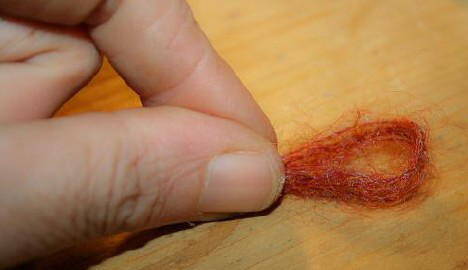
Take the loop with the crochet hook and pull up to form a slot, and then insert the hook into the slot (how to make the chain stitch), take the wool threads protruding from the other side and pull them out altogether. Tighten securely.
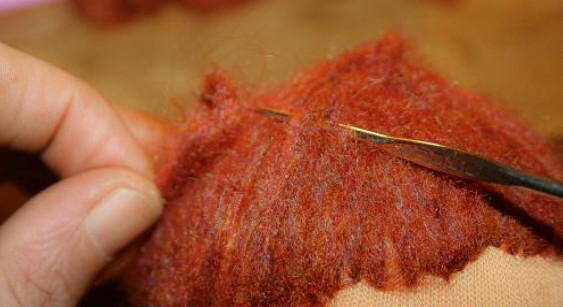
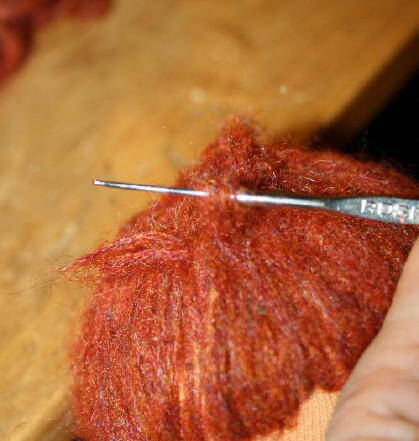
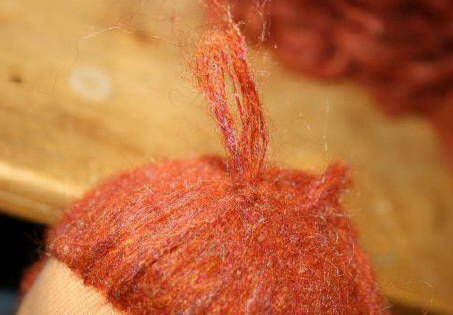
WALDORF DOLL TUTORIAL – Fringe
(Doll with cap)
Draw a line symmetrical, but rather high compared to the normal hairline:
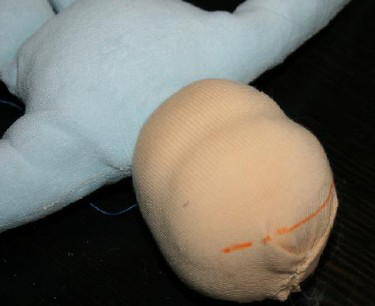
With the wool choice for the hair embroider some long stitches in correspondence of the drawn line, taking with the needle also a bit of padding.
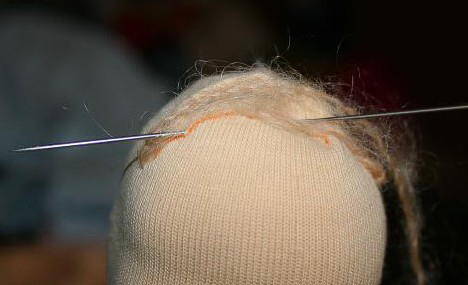
Then insert the hair with a crochet hook, two by two, as explained for short hair. There is no need in this case also taking the jersey with crochet.
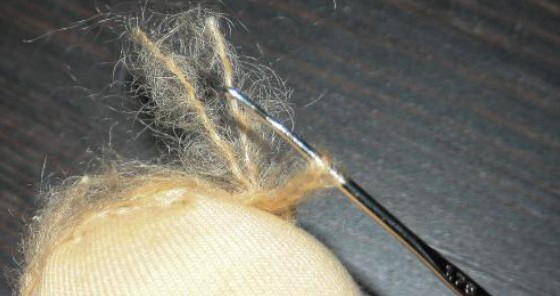
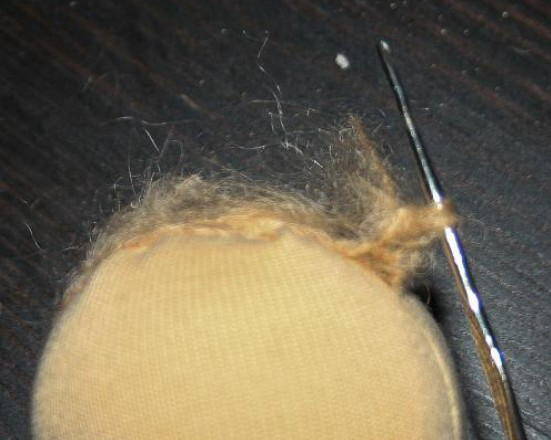
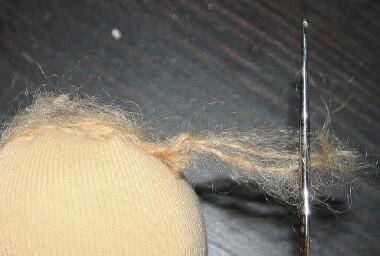
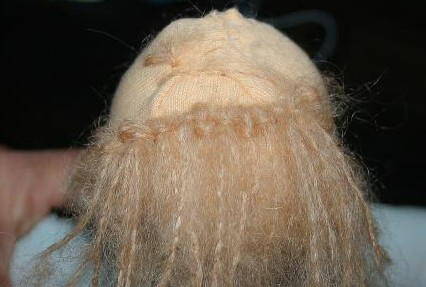
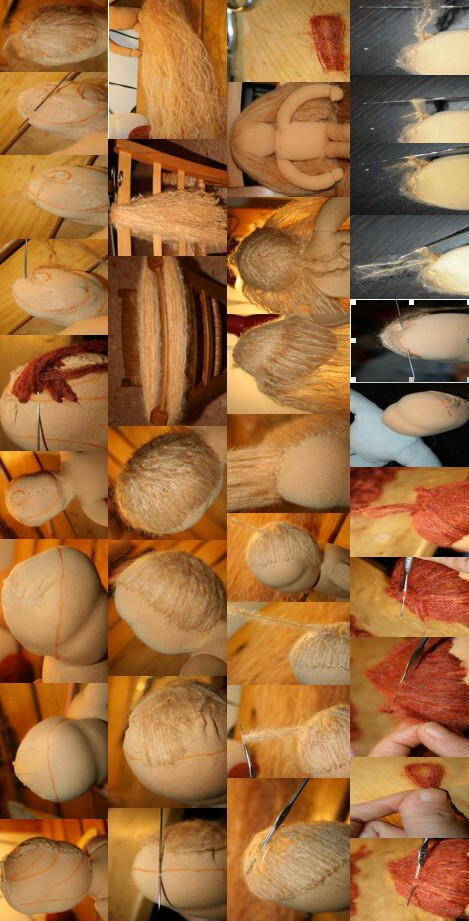
WALDORF DOLL TUTORIAL – Body of the doll with chenille body and cap
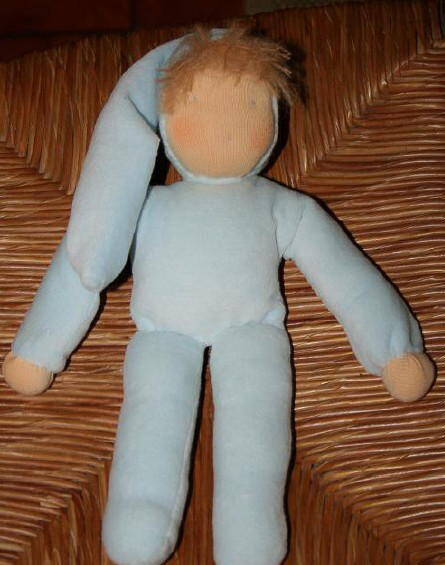
Trace the outline of the pattern for the body, on the chenille made double, with the right inside, and the back outside.
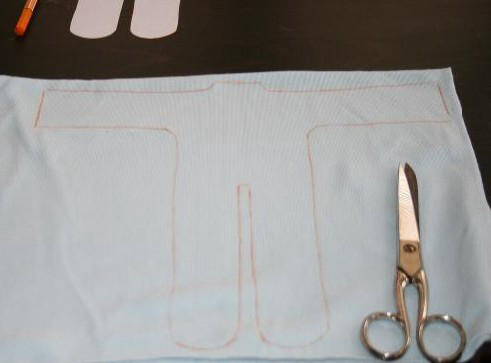
For the cap does not put the jersey double if you use the entire pattern, use double if you fold the pattern in half.
Sew along the signs, cut with scissors, leaving a margin of about 0.5 cm.
Overthrow on the obverse.
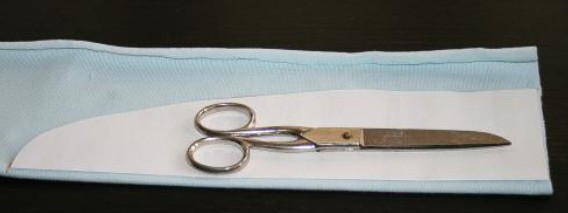
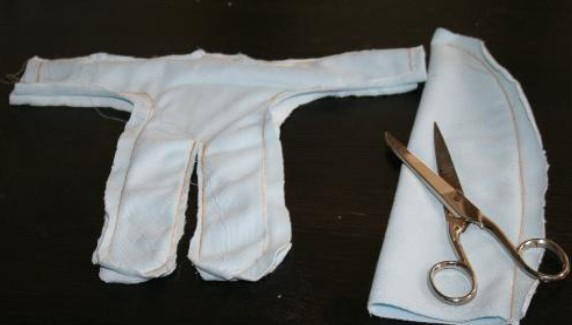
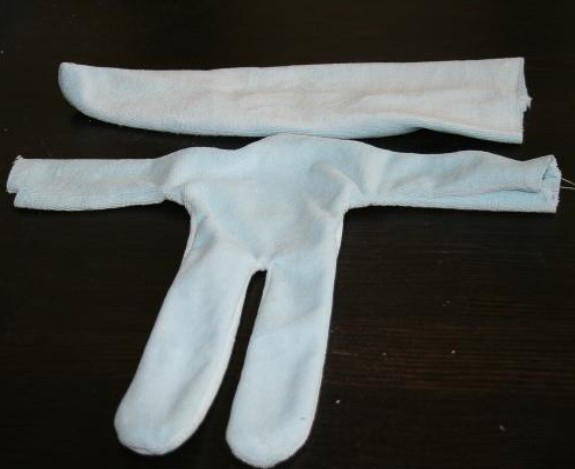
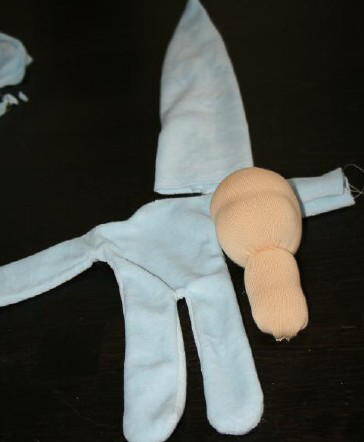
Start making the padding of the legs, following the counsels given for the padding of the Waldorf doll.
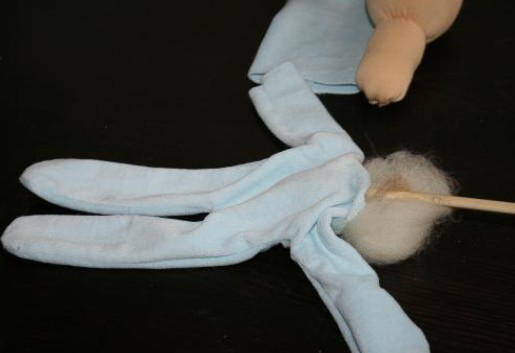
Arrived with padding at the groin, sewing with embroidery thread, making a seam nice and symmetrical, allowing the doll to sit. This seam will enable the doll to be well seated.
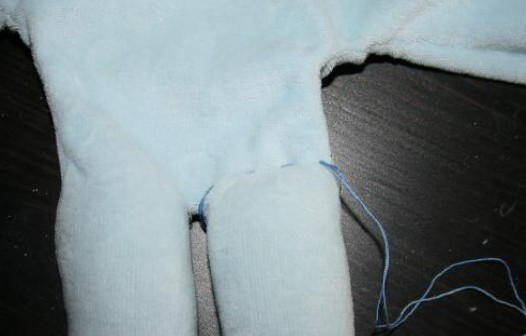
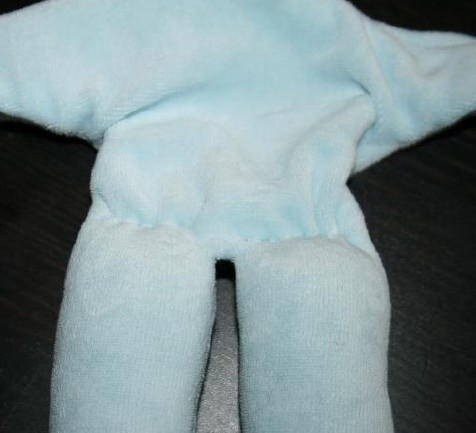
Pulling well embroidery thread, and making small stitches, the seam will disappear naturally in chenille, and do not need further refinement.
Now take two strips of wool, tie a knot in the middle, then bring down the wool. Close with other wool turning around the knot, in this way:
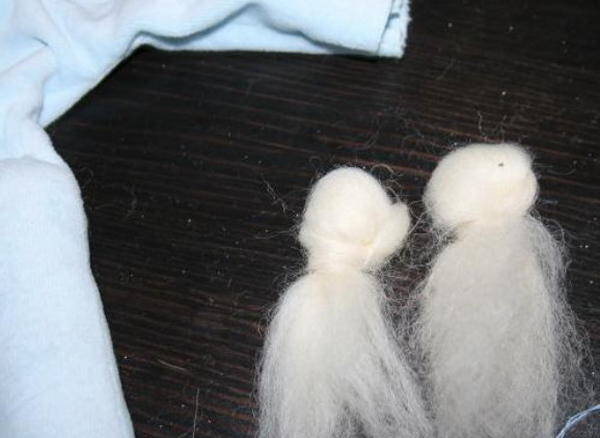
These two knots, covered with jersey, will become the hands of the doll.
Be careful that they are as equal as possible between them.
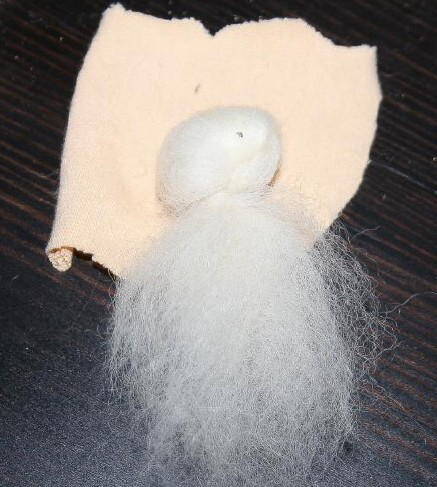
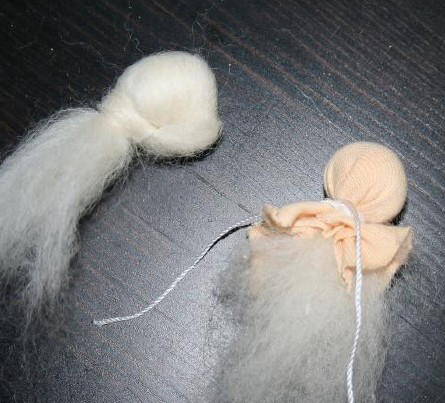
For dimensions, do as you like.
Sew the arms to the hands.
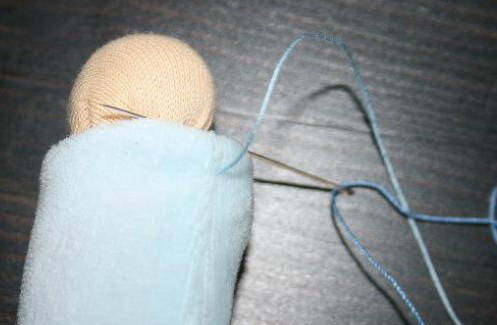
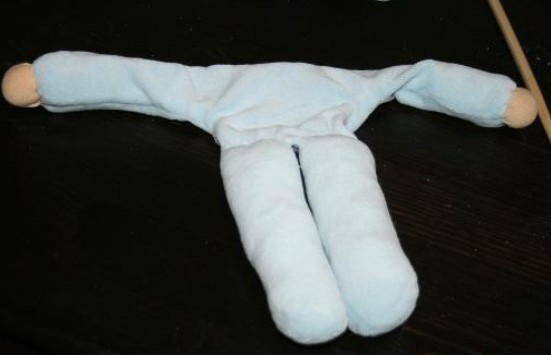
Then make the padding of the arms, put the doll’s head and continue with the padding of the tummy.
Making sure that the front of the doll is more rounded, and the back flattest.
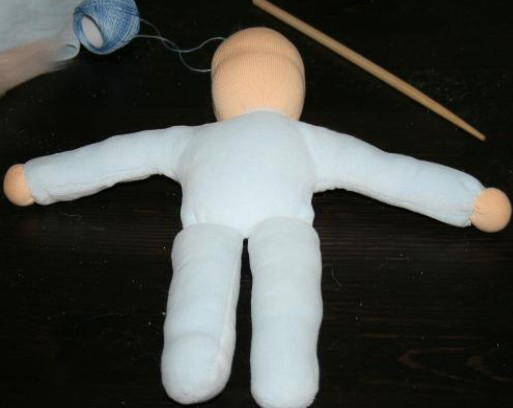
Sew the head on the chenille around the neck.
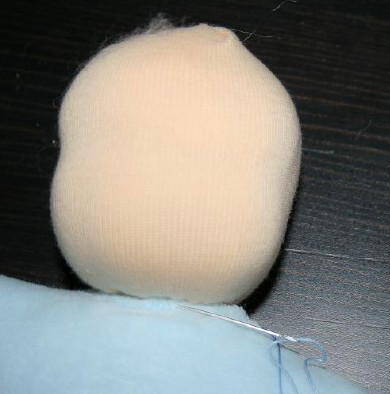
Making the fringe of hair, as explained above, insert the cap and sew it around the neck and around the head (face and nape).
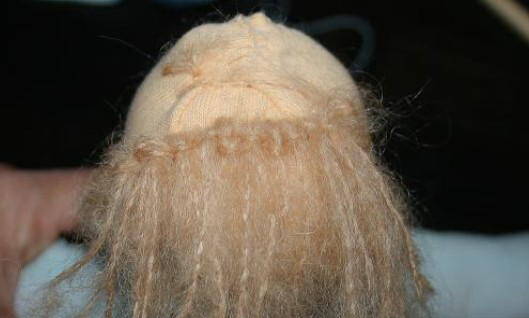
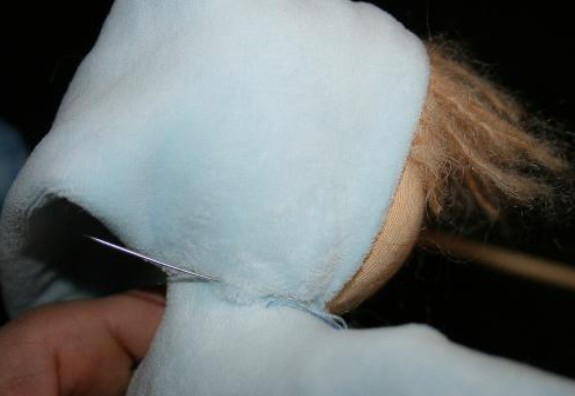
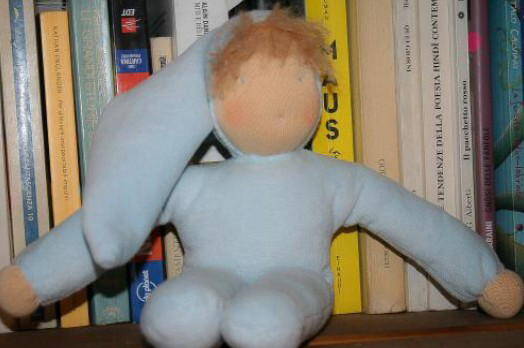
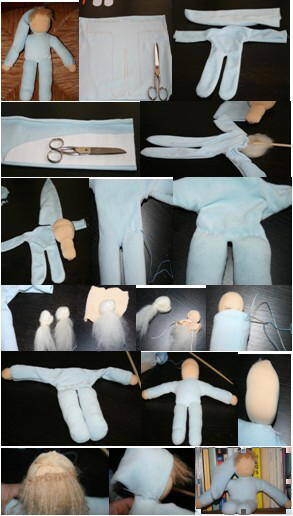
WALDORF DOLL TUTORIAL – Eyes and mouth
First color a little, with a chalk pink, the cheeks. Deploy the chalk on the cheeks with the aid of a wad of wool.
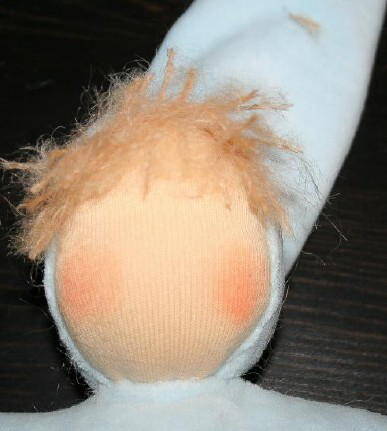
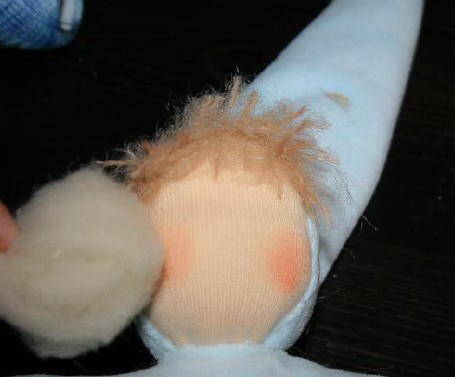
Then take three pins, and do various tests for the placement of the eyes and mouth.
The eyes should fall on the ligature, and should form an equilateral triangle with the mouth.
Note that the equilateral triangle is intended to prevent eyes too close or too far apart, and to prevent embroider the mouth too high or too low.
Move several times the pins, and observe the doll’s face from a distance, calmly, as long as we are not really satisfied, and we can move on to embroidery.
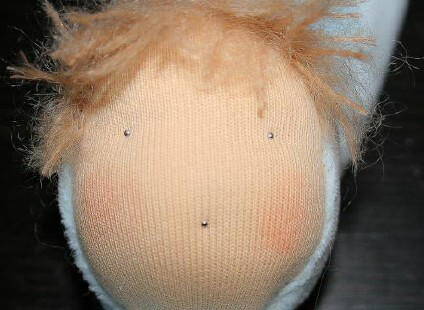
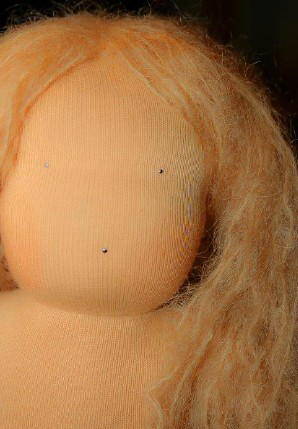
Thread the needle with cotton thread of the same color jersey, and sew the jersey on the padding, with small stitches, where there are the pins:
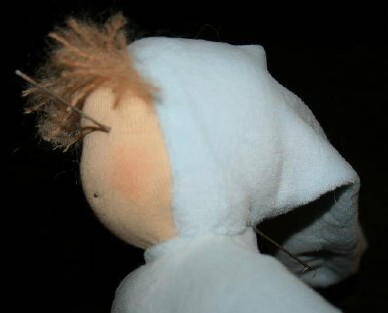
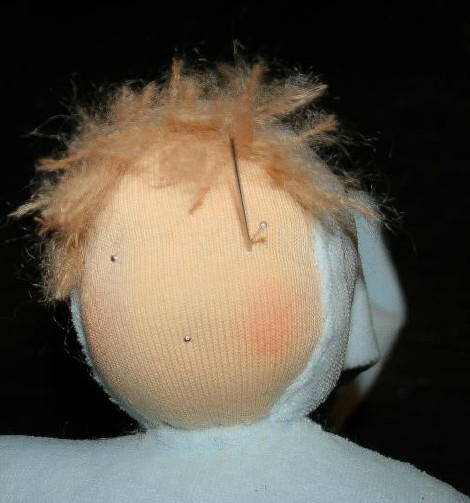
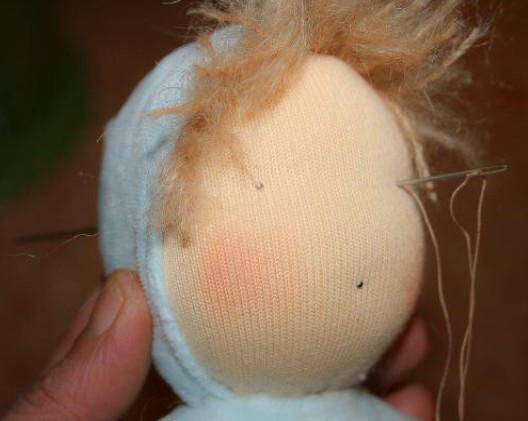

Then finally embroider eyes and mouth, with the colors you want. For the eyes you can make simple knots, especially on smaller dolls.
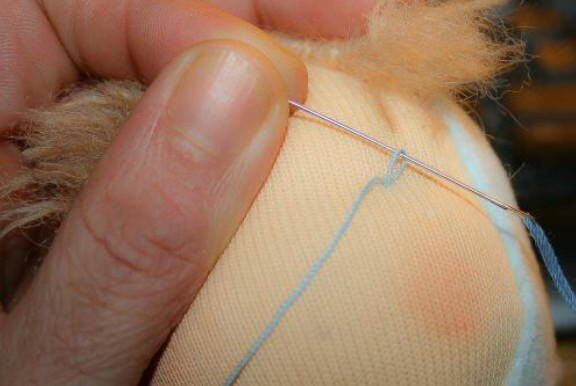

If embroidering larger eyes, count well the meshes of the jersey to be able to make them the same size and the same shape.
The mouth can be done as a dot pink or red, or smiling as crescent-shaped.
If the doll is for your child, I suggest you characterize it as little as possible, and then readjust according to directions of the child.
Maybe he / she will take the eyes of his / her doll bigger or in a different color, the mouth in another way: is the beauty of making toys at home…
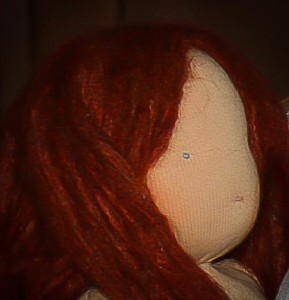
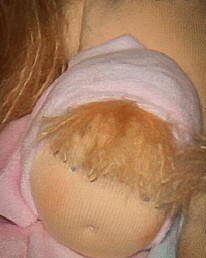
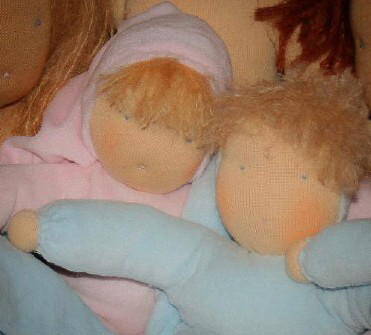
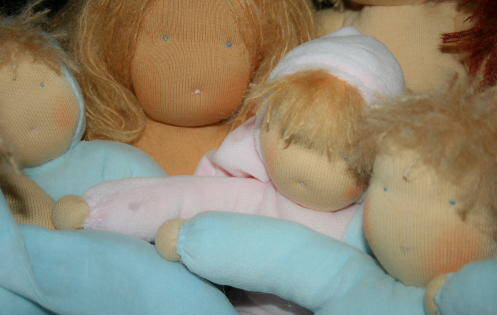
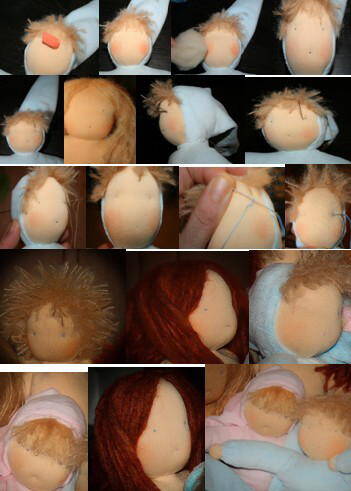
WALDORF DOLL TUTORIAL – Patterns
Instructions for making the patterns
Essentially the pattern for the Waldorf doll is a rectangle.
Place the doll’s head on a sheet of paper, mark the width and the length and measure.
The width of the pattern of the body will be equal to the width of the head; the length will be the length of the head multiplied by three.
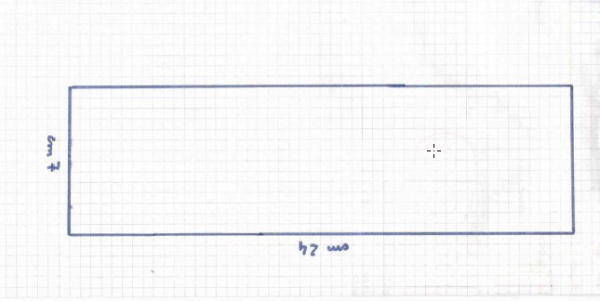
In the example the head measuring 7cm wide and 8cm in length, then the model will measure 7×24 cm (24 = 8 x 3)
Now divide the rectangle in half and draw a line:
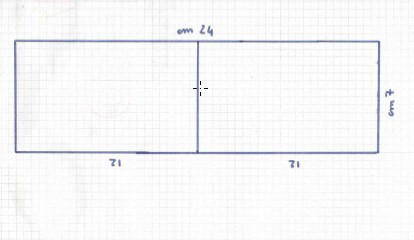
Divide the line in half and then the right and left marked 0.5 cm.
Mark the half also the lower side of the rectangle and mark 1cm each side.
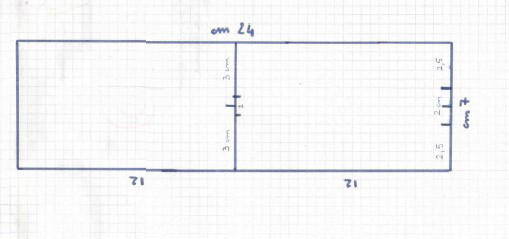
Join together the points found, and then draw two rounding at the bottom, in proportion to the width of the ankle, for the foot.
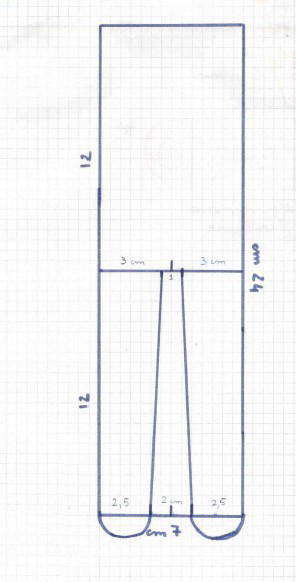
For the arm, wrist passes through the center of the rectangle, the thumb is located on the median line, and the width corresponds at half bust.
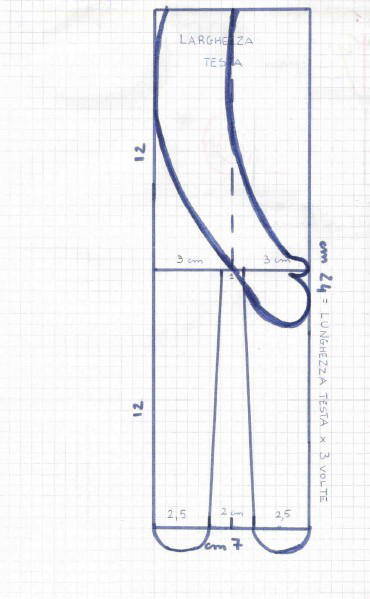
As you can see it is very simple, and if you work with children, they will have great satisfaction and each doll will be unique.
If you prefer, you can find the patterns, ready to print and full size…
Waldorf doll – pattern – doll medium size (pdf): pattern 1 pdf
Waldorf doll – pattern – doll big size (pdf): pattern 2 pdf
Waldorf doll – pattern – doll with articulated limbs (pdf): pattern 3 pdf
Waldorf doll – pattern – doll with fabric body and cap (pdf): pattern 4 pdf

